
*Photo credit: © Claire Arnot
Yes, we have bobcats in the greater Phoenix area. In fact, bobcats are common throughout Arizona and found in all contiguous states in the USA with possibly one or two exceptions. In Arizona, and specifically the Sonoran Desert, they especially thrive in forested mountains, rocky canyons and dense brush areas. Sometimes referred to as wildcats, the development and occupation of their natural habitat has forced bobcats to adapt to living in more populated areas which include our suburbs and the outskirts of cities.
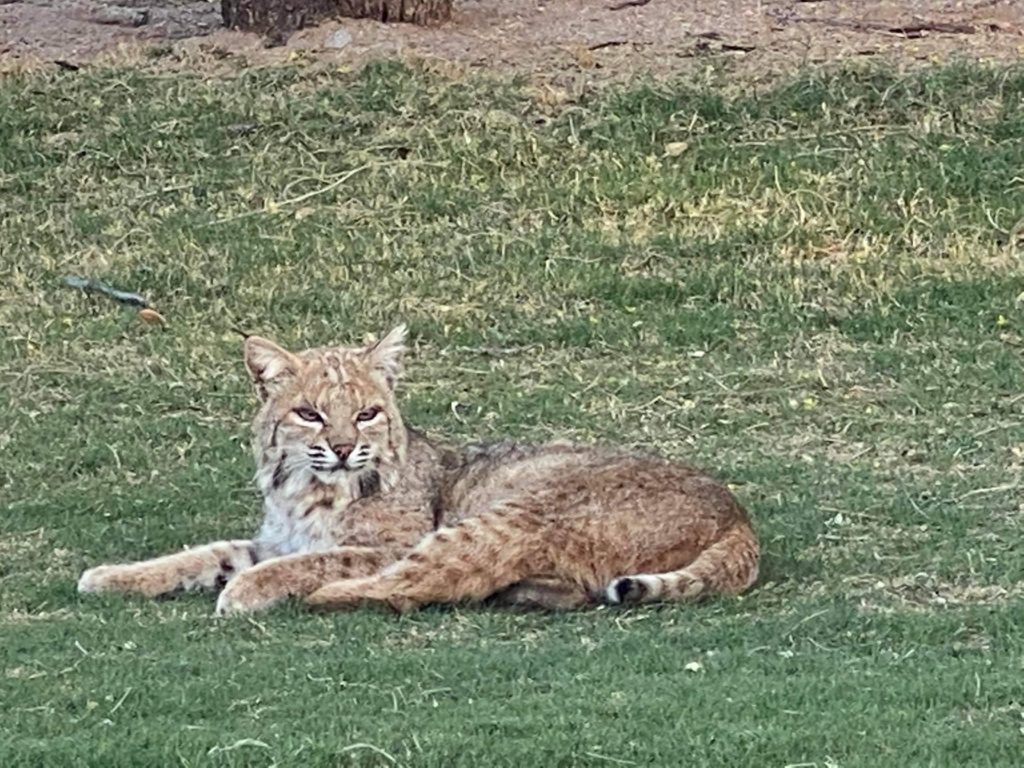
*Photo credit: © Cindy Beardsley
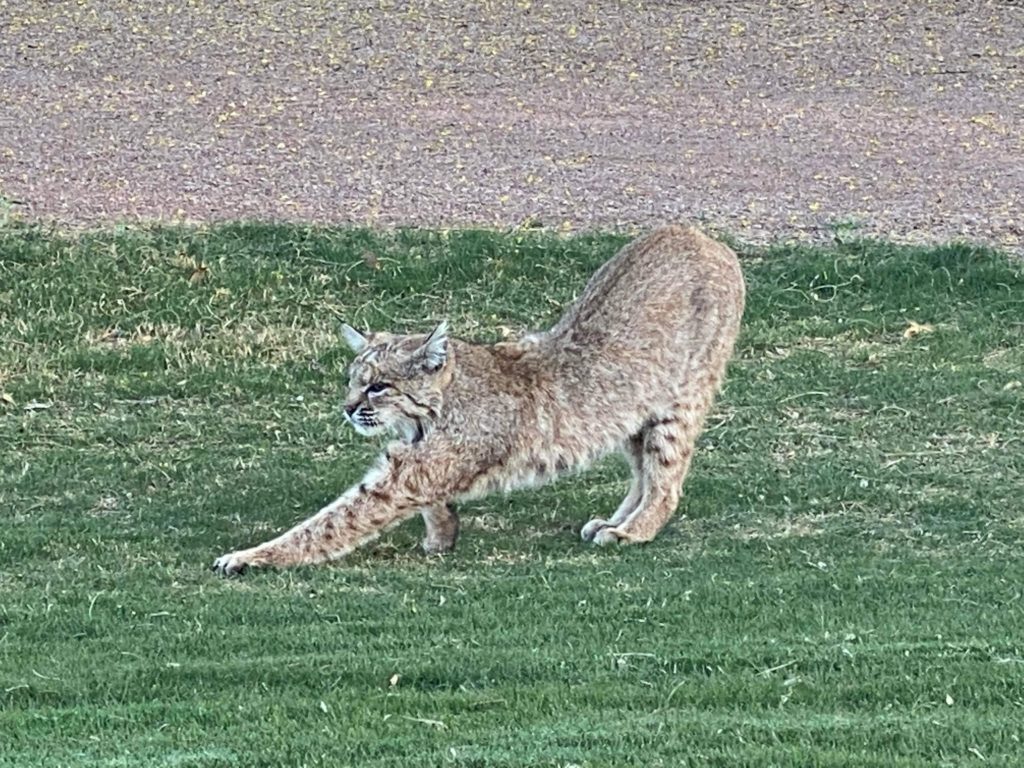
*Photo credit: © Cindy Beardsley
Identifying Bobcats
Bobcats, named for their bobbed tails, are bigger than house cats but smaller than mountain lions. They have flat faces, furry cheeks, long legs and big paws. Size-wise, they are 18 – 24 inches tall, 2 – 3 feet long, weigh 15 – 35 pounds and have tails that are 2 – 8 inches in length. Bobcats can jump heights of 10 plus feet and climb small trees. On the move, they are usually solitary unless it’s a female moving kittens between dens, siblings or mating pairs. In Arizona, breeding usually occurs December through April. The kittens are born April to early June and litters are mostly 2 – 3 in number. The kittens stay with their mother for most of their first year and start learning to hunt at 4 – 5 months. The average lifespan of a wild bobcat is 12 – 15 years.

*Photo credit: © Cindy Beardsley
Bobcat Behaviors
Pouncing on their prey like mountain lions, Arizona bobcats are opportunistic carnivores with a menu that includes rabbits, rodents, other small mammals, birds and occasionally lizards and snakes. Occasionally they are seen eating small deer and pronghorns. Unsupervised cats and small dogs also provide meals to hungry bobcats who are known to visit backyards in search of food and water.
These shy and often reclusive animals are nocturnal hunters but may be spotted sleeping or reclining during daylight hours. Some favorite roosts are dens, low tree branches, hollow logs, tree and bush thickets, and caves. In developed areas bobcats choose patios, under decks, empty lots, enclosed yards, rooftops or driveway culverts – any place where they feel secure for a daytime nap.
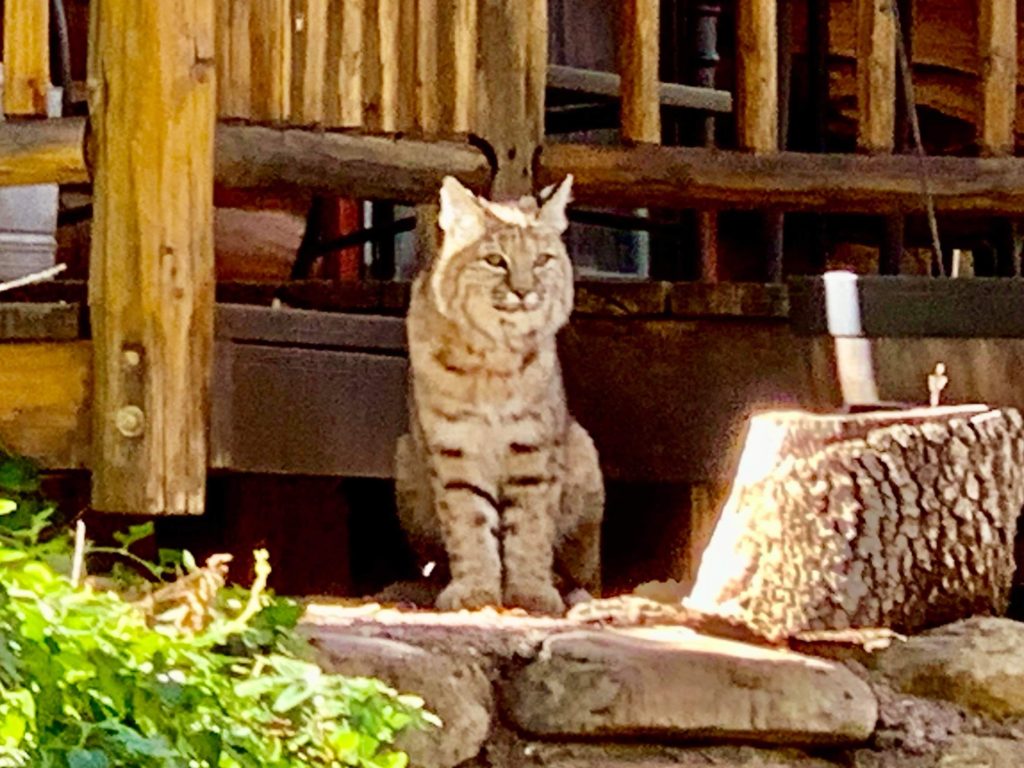
*Photo credit: © Foofoo Sullivan
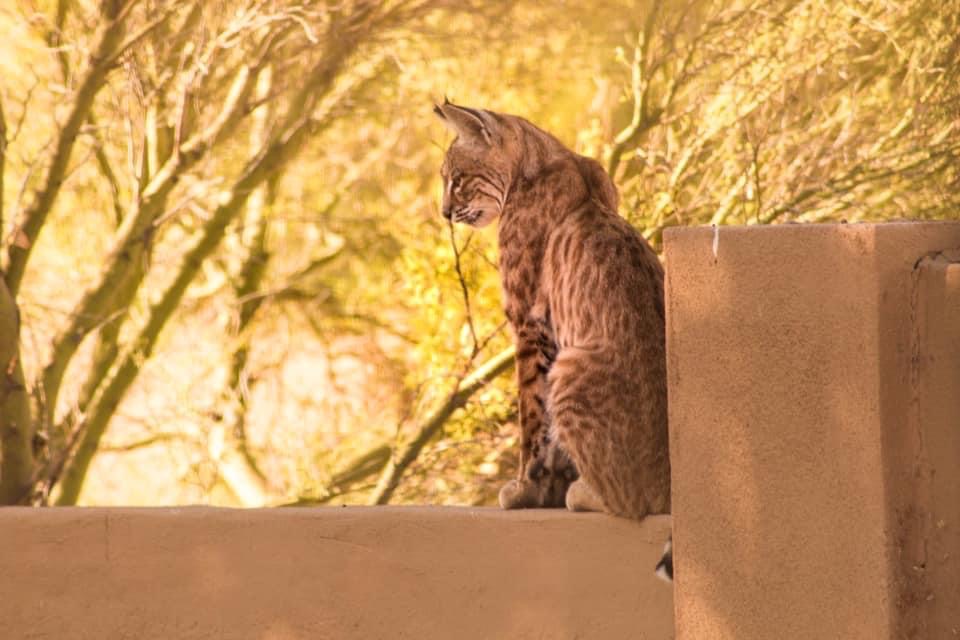
*Photo credit: © Beth Tierney Jablonski
It’s important to note that bobcats almost never attack humans. The few documented cases involve bobcats with kittens or rabies; however, rabies in bobcats is very rare.
In Arizona bobcats are considered a species of concern with populations relatively stable overall. You must have a license to hunt bobcats and keep in mind that most Arizona cities ban shooting firearms within city limits. Possession of live bobcats is illegal.

*Photo credit: © Beth Tierney Jablonski
What To Do If You See A Bobcat
- As with all wildlife, keep your distance! Attempting to touch or feed is not appropriate.
- Do not turn your back or run which may invite the cat to chase or attack you. Instead, back away and use loud noises and arm movements to distract and scare away.
- Spraying with a hose or throwing water are also deterrents since, like most other cats, they do not like water.
- If you have a small pet, pick it up to make the pet appear larger.
- If the cat appears to be unhealthy, please contact Arizona Fish and Game or your local wildlife commission. Do not attempt to capture or treat.
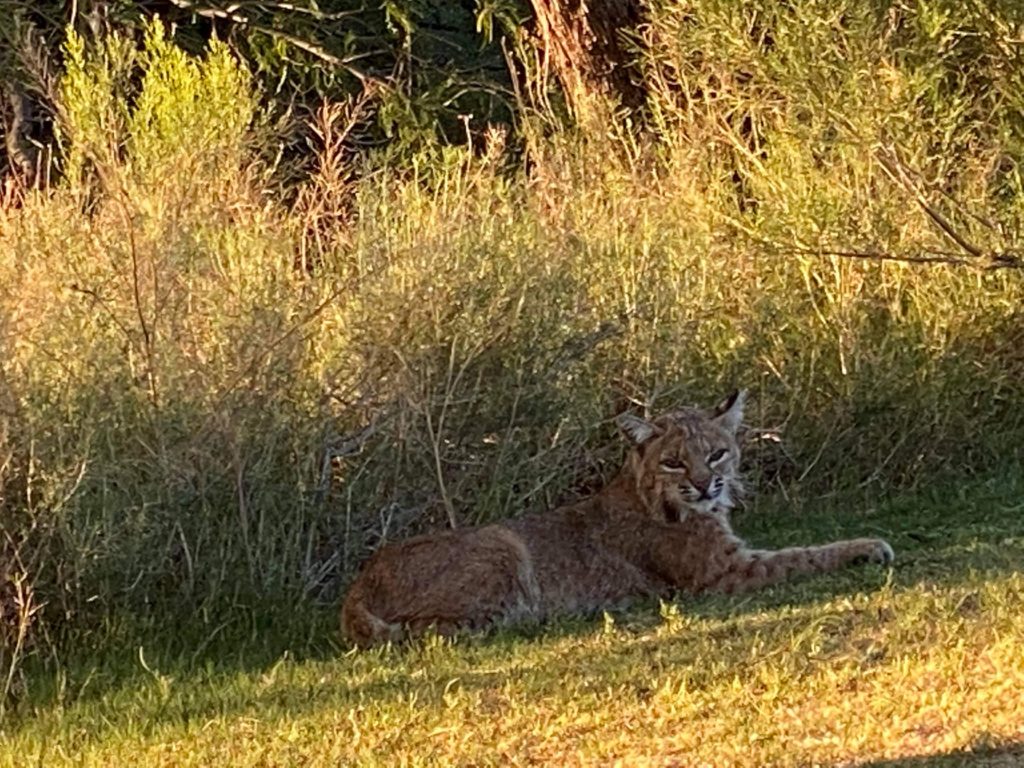
*Photo credit: © Cindy Beardsley
Important Wildlife Safety
Wild animals are exactly that, WILD! Their response to human encounters is unpredictable at best. When wild animals injure people they are removed or euthanized because of people’s behaviors. Please act responsibly!
The following applies to all wildlife and within the greater Phoenix area especially relates to bobcats, peccaries and coyotes.
- Keep a respectable distance from all wildlife and do not interfere with their natural behaviors.
- Never feed or harass wild animals.
- When hiking, stay on trails and keep pets under control on a short leash.
- Supervise your pets in yards and especially dusk to dawn.
- Trim vegetation around your home to discourage animals from seeking refuge.
- Avoid leaving food overnight in front or back yards. This includes birdseed, pet and human food.
- Report unhealthy looking animals to the local wildlife commission. Never attempt to capture or treat.
Arizona Vacation Home Rentals has a home, Bobcat Den, that has a neighborhood bobcat. The cat is sometimes spotted napping in the home’s front and back yards. It’s quite likely that you will view bobcats at some of our other homes and especially if there are green spaces that border the homes.
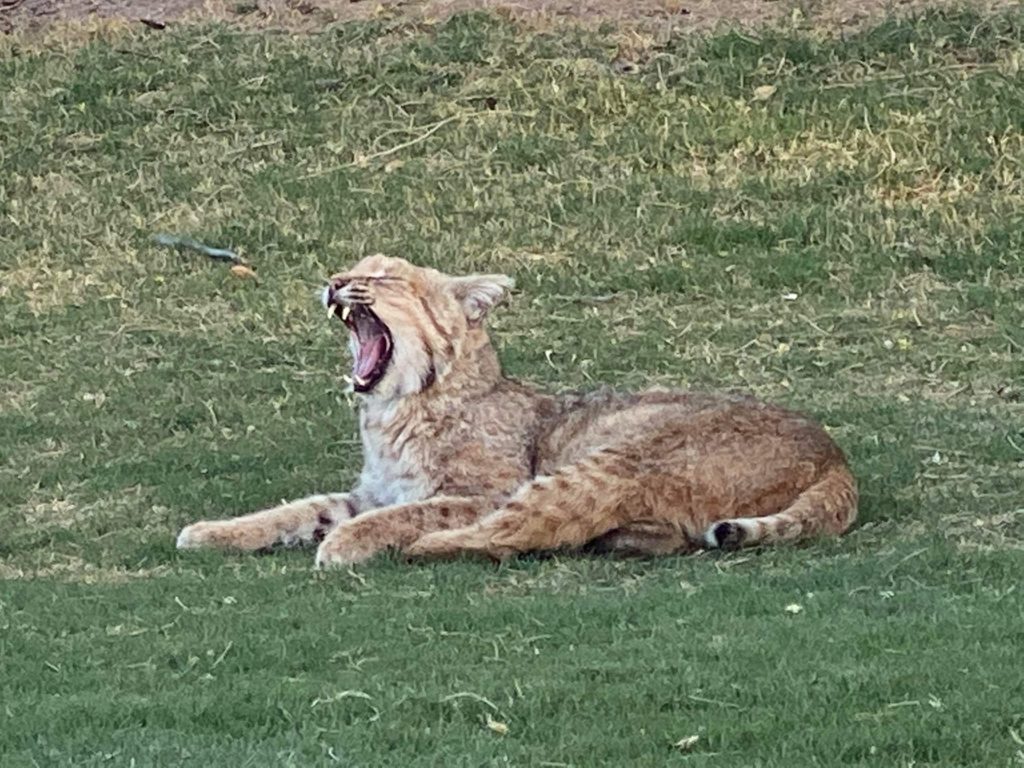
*Photo credit: © Cindy Beardsley
Save money and support local business by booking directly through
Arizona Vacation Home Rentals
Phone/Text: 480.626.4072
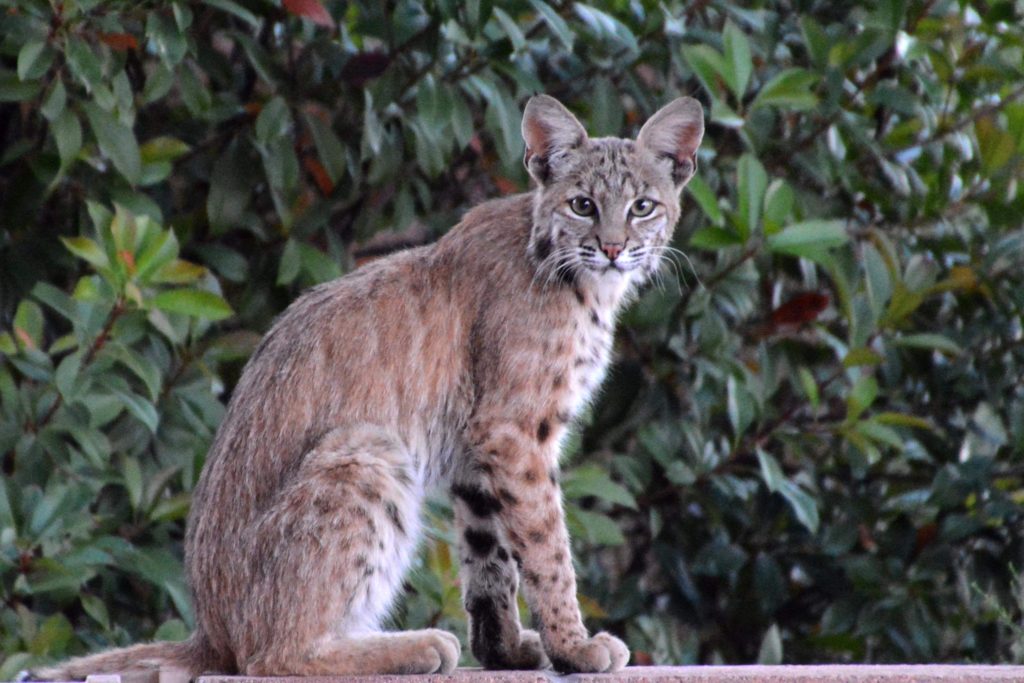
*Photo credit: © Ken Krahulec
* Special thanks to all the Sonoran Desert Wildlife group members who contributed bobcat photos for this blog!
Across the United States, local and state governments are exploring ways to micromanage the short term rental (STR) industry. The controls they seek come in the form of additional fees and taxes for STR properties, limiting the number of STRs in a given area or banning STRs altogether. Home Owner Associations (HOA) are also expressing their opinion of STRs by including covenants that prohibit STRs and harassing guests who stay at permitted STR properties.
Why? Media publications occasionally try to stir up trouble by incorrectly printing that STRs negatively affect housing availability and costs. But largely the opposition are a few people who are annoyed (justifiably or not) with STR guests in their neighborhood. These grumblers join HOA boards or get elected as local commissioners to oppose STRs and go so far as to embroil others to revise the STR statutes in their community. Some are unconscionable and reward homeowners for reporting or even fabricating problems with STR guests in an effort to promote their anti STR agenda. The NIMBY (not in my backyard) phenomenon comes to mind because most of the STR opposition admit to using STRs when they travel.
Direct and Indirect Contributions
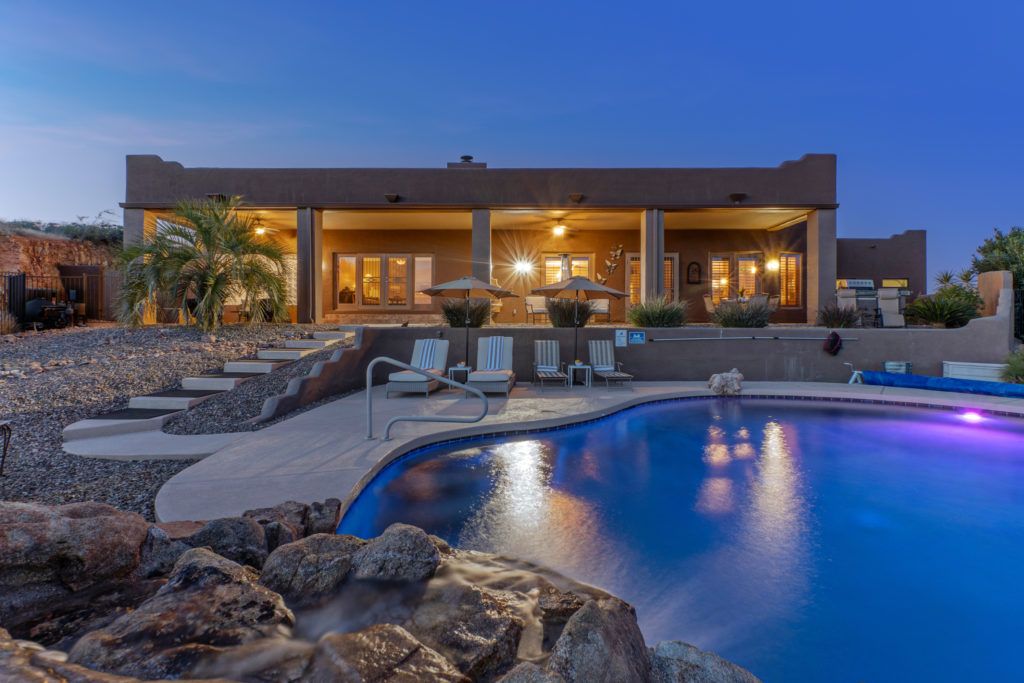 I’m here to say, watch what you wish for! I live in an east coast city that was once home to a lucrative film industry. In the last 40 or so years, more than 400 movies and several TV series as well as individual episodes, were produced here. Less than a decade ago, sketchy local and state politics that included initiatives to shrink film industry incentives and ban short term rentals (preferred housing of actors and crews during filming) sent full time agents and producers in search of more user friendly settings. Quickly and quietly the agencies and their crews vanished to other states taking with them scores of people who made their living providing services they needed: hair styling, make-up, costume design, set design and special effects to name a few.
I’m here to say, watch what you wish for! I live in an east coast city that was once home to a lucrative film industry. In the last 40 or so years, more than 400 movies and several TV series as well as individual episodes, were produced here. Less than a decade ago, sketchy local and state politics that included initiatives to shrink film industry incentives and ban short term rentals (preferred housing of actors and crews during filming) sent full time agents and producers in search of more user friendly settings. Quickly and quietly the agencies and their crews vanished to other states taking with them scores of people who made their living providing services they needed: hair styling, make-up, costume design, set design and special effects to name a few.
No big deal you might think but keep reading! The people who left had contributed both directly and indirectly to our local economy. They bought coffee at Starbucks, dined in our restaurants, shopped at our stores, rented or bought properties and participated in local events. In other words, they spent their time and money here. The celebrities and shows made us famous which attracted tourists from all over the world who came and spent their time and money here. We were the winners: we saw increased tax revenue and job growth, especially in tourist and service factions. Unfortunately and not surprising, when the major and minor players in the film industry relocated to greener pastures their spending power and influences moved with them.
Connecting the Dots
How you wonder are filming and STR companies like Arizona Vacation Home Rentals similar? For starters, they are both environmentally clean industries as opposed to corporations that pollute water, soil and air and spend our tax dollars to clean up their mess. If you aren’t a tree hugger and this doesn’t matter to you perhaps I can hook you by explaining how the STR industry, similar to the film industry, positively impacts the local economies in Arizona.
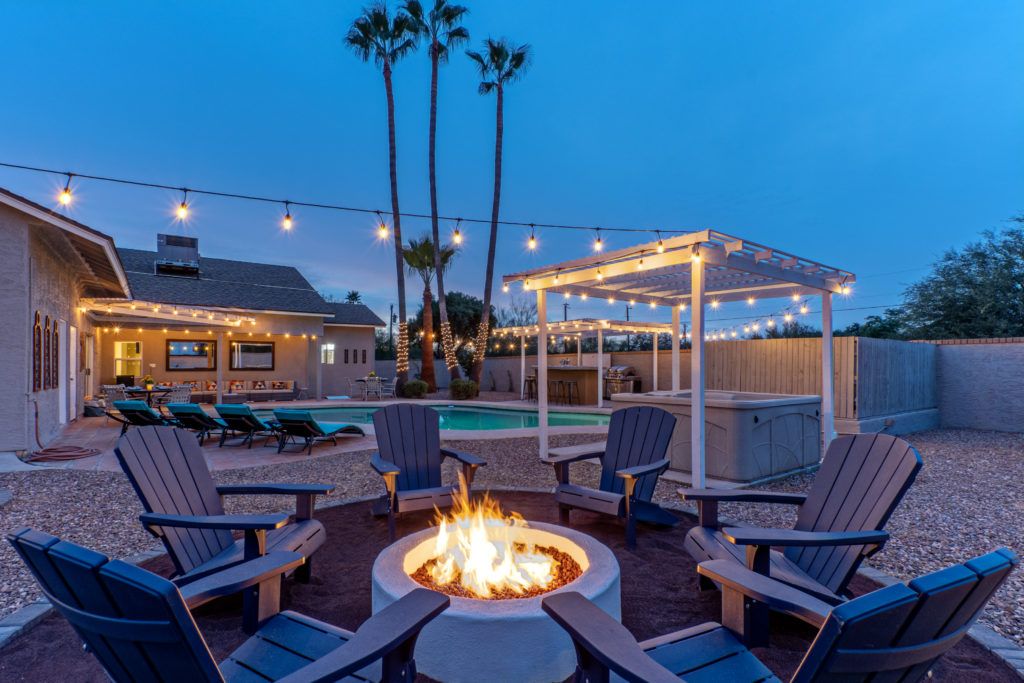 Rounds Consulting Group (RCG) conducted an economic impact analysis and published the results in The Economic Impact of Short-Term Rentals in Arizona, February 2022. The results are impressive! Guests who stayed at STR properties generated $538.4 million dollars in Arizona county and city tax revenues in 2021. These included taxes levied on rental fees, sales taxes from guests’ spending and tax revenues from the 75,500 jobs created by the short term rental industry.
Rounds Consulting Group (RCG) conducted an economic impact analysis and published the results in The Economic Impact of Short-Term Rentals in Arizona, February 2022. The results are impressive! Guests who stayed at STR properties generated $538.4 million dollars in Arizona county and city tax revenues in 2021. These included taxes levied on rental fees, sales taxes from guests’ spending and tax revenues from the 75,500 jobs created by the short term rental industry.
RCG used a common economist model that measures the effects of activities related to the industry and converts the activities into estimated tax revenues. They included direct effects such as taxes generated by guests as they spend money in the locale where they are staying e.g., dining at restaurants, playing golf, buying food and visiting attractions. They also counted what they labeled as secondary impacts that result from increased demands on companies that supply goods and services to the STR industry. Examples of this include the tax increase in revenue and jobs or payroll hours affiliated with the suppliers of goods and services to STR companies e.g., housekeeping and maintenance crews, cleaning supplies and fuel. And as RCG points out, the rippling effect continues as employees of the suppliers spend their earnings on goods and services and so on and so forth.
Before you support or vote in favor of limiting or banning STRs think long and hard about $538.4 million dollars in tax revenues and 75,500 new jobs. Those are BIG numbers! Everyone benefits, everyone is a winner because more people are working and tax revenues pay for schools, roads, first responder salaries and equipment, and so much more, without raising everyone’s taxes.

The Blame Game: Get It Right!
You should also contemplate this: long term renters have a greater negative impact on communities and house prices than STR guests and homes. If you doubt me, talk to a landlord. Their top 3 challenges include evicting tenants who stop paying rent (good luck with this!), periods of vacancy between tenants and property damage. Next, talk to a realtor who will confirm that these behaviors directly contribute to the decline of neighborhoods and falling home prices. STRs are not problem free but evictions, property damage and in most cases vacancy are rarely the challenges. The very nature of STR income motivates homeowners to keep their properties occupied and in excellent condition, stay on top of problem guests and resolve damages quickly in preparation for incoming guests. These desirable behaviors contribute to maintaining everyone’s property and community values and promoting neighborhood civility.
Support Clean Industries
Hands down, the benefits of STRs far exceed the few nuisances, but that’s another blog (to be written soon). For now, don’t make the mistake my urban area did and allow an environmentally friendly and lucrative industry to decline or disappear. My home city is currently scrambling to right their mistakes and encourage the return of full time filming productions. Be smarter! At the very least, elect representatives and vote in favor of ordinances that support STRs in your community. If possible, get involved to help ensure STR regulations make good neighborly sense without limiting their ability to contribute generously to Arizona’s economy and job market.
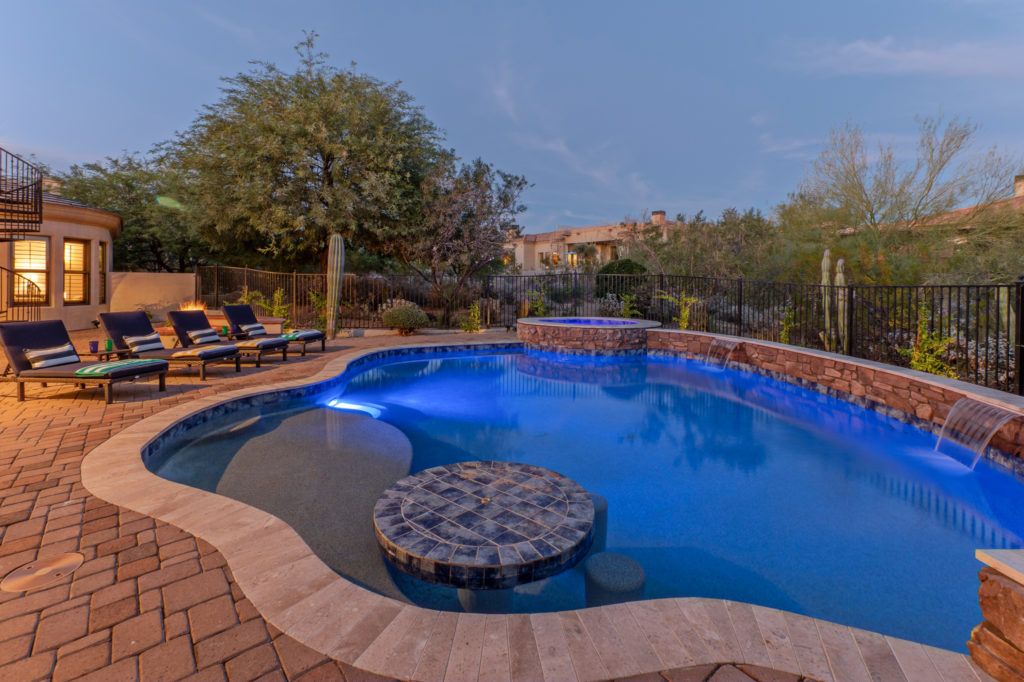
Save money and support local business by booking directly through
Arizona Vacation Home Rentals
Phone/Text: 480.626.4072
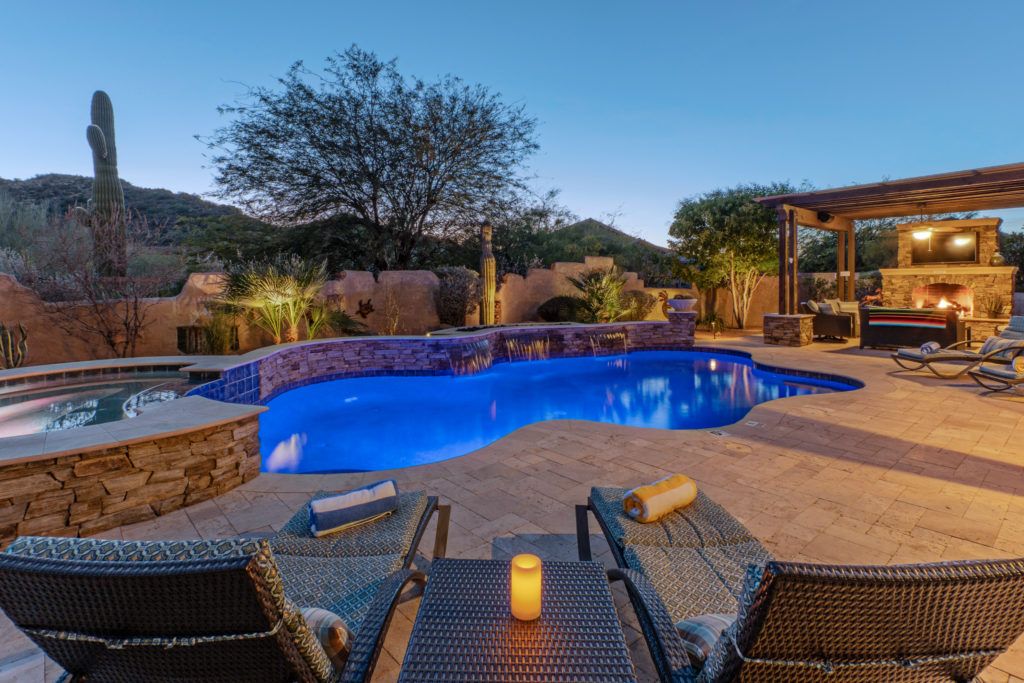
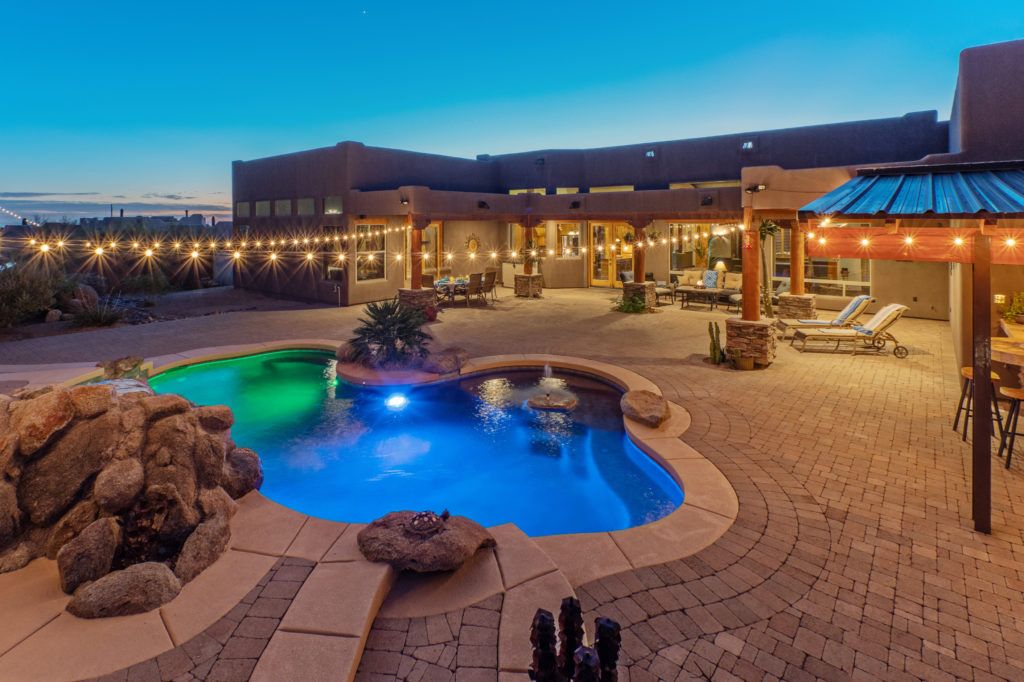
A recent and popular trend with business travelers as well as families on the go is to stay in a vacation rental home instead of a hotel. If you haven’t explored renting a home in place of reserving a hotel room, keep reading…

Four Advantages to Vacation Rental Homes
1. Space and Well-being
It’s about space (lots more) and convenience:
- You can spread out and make yourself at home.
- There is more privacy for sleeping, working and all other activities.
- Everyone isn’t sharing one bathroom or one bedroom or one TV.
- You can have fresh brewed coffee (in a Keurig no less) at any time and in your pajamas (one of my favorite reasons).
- There are multiple televisions to match your viewing preferences.
- Some homes have garages to protect your vehicles, golf clubs, bikes and other gear.
- Homes are self-contained meaning everything you need except food, paper products and personal items are provided.
- Spaces are safer if you want to quarantine.
- Homes give you the space you need for a staycation.

2. Cost Effective
Hotels cost more than rental homes:
- Multiple families, couples or corporate executives can save by sharing a home.
- You can eat healthier and save money by preparing meals in the home.
- Parking is free.
- You can avoid baggage fees by packing less because your laundry can be done in the home.
- There are no hidden costs for the internet, pool towels, laundry, parking or more than one bed.

3. Comfort and Flexibility
Vacation rentals offer more flexibility and benefits:
- Homes are usually cleaner, safer and in quieter neighborhoods than hotels.
- Versatile booking options include length of stay as well as early arrivals and late departures.
- You can choose from a variety of amenities such as private pools, spas, putting greens, fire pits and games
- You’re not expected to share the amenities or elevators, lobbies, etc. with strangers.
- You can mix with the locals and discover the community’s hidden jewels such as the best restaurants, bars, museums and hiking trails.
- Homes offer a variety of floor plans and may be well suited for business meetings or team building conferences.
- You can work and play at the same location if you choose a home with a ping-pong or pool table, bikes, kayaks, nearby trails or a swimming pool.
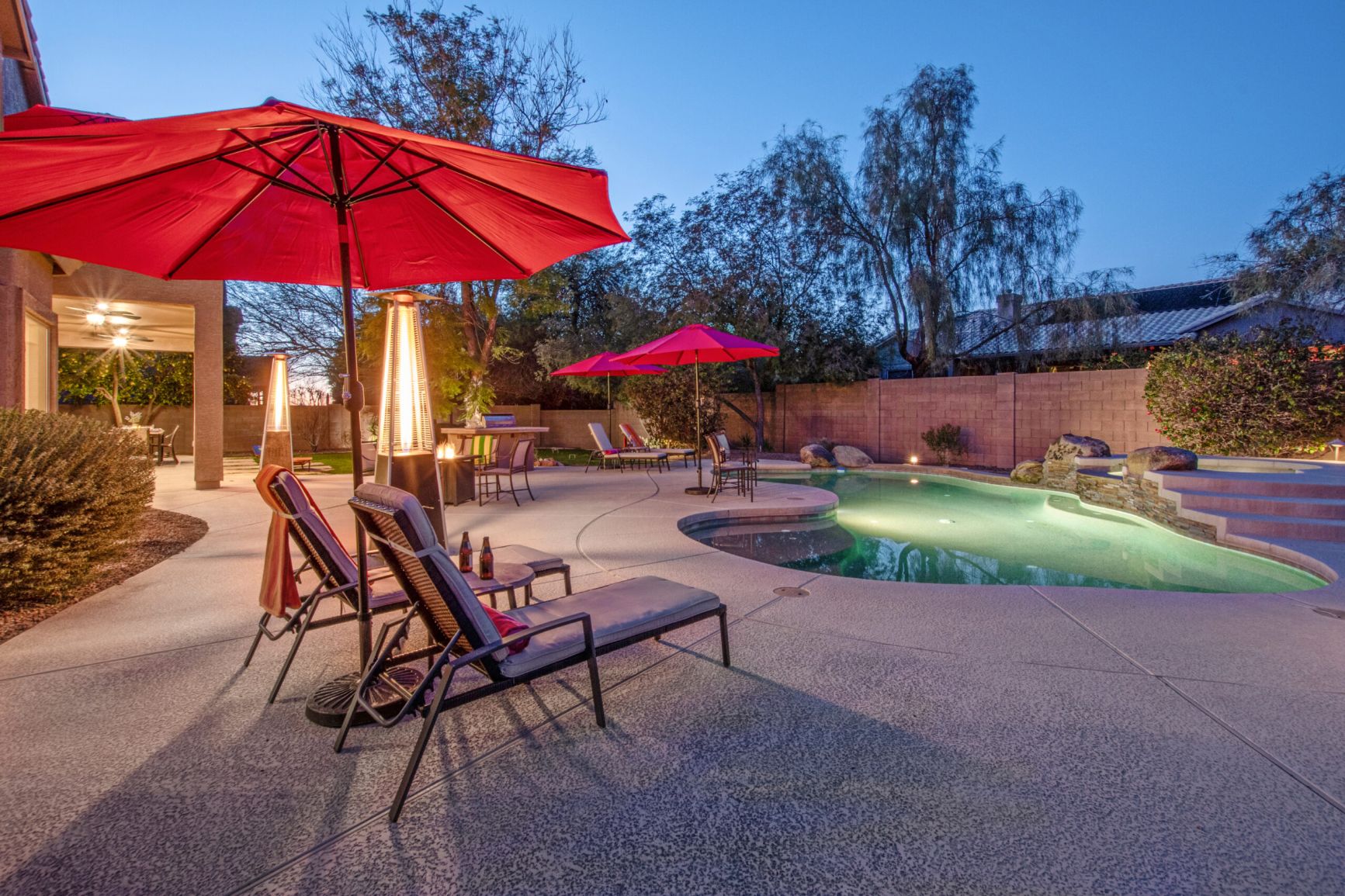
4. Safety
Vacation homes are safer:
- Vacation rental properties offer you a self contained home so you can avoid crowds and public spaces.
- Check-in and check-out are contact-less.
- Meals can be prepared and served at the home.
- All of our homes have laundry rooms with washers and dryers so you can avoid public laundromats.
- Remote work, school and play can all be conducted at one place.
- Rental homes have amenities such as pools, hot tubs and putting greens that are not shared with strangers.
Vacation rental homes are literally everywhere. Once you’ve determined your destination you can find the ideal home by locating a local Online Travel Agency (OTA) such as Arizona Vacation Home Rentals, searching the homes on their websites and contacting the property managers. Booking directly with OTAs and avoiding the large vacation rental markets is a HUGE money saver!
Arizona Vacation Home Rentals offers a wide variety of rental properties in the Greater Phoenix Area. Our local team will personalize your experience and make you glad you decided to rent one of our homes!
Save money and support local business by booking directly through
Arizona Vacation Home Rentals
Phone/Text: 480.626.4072
AVHR Winter Newsletter 2021
Second edition
Welcome! This quarterly newsletter will give you the scoop on Arizona Vacation Home Rental’s newest homes and winter activities in the greater Phoenix area. In addition, look for the following:
- guest discounts
- weather overview
- travel tips
- what you need to know about pool heating
- links to help you find more information
We encourage you to browse and find what you need to customize and plan the perfect Arizona vacation.
Discounts if You Book at Azvacationhomerentals.com
When you’re ready to book ask us about the following discounts:
- 5% discount on nightly rate for returning guests
- 5% discount on nightly rate for veterans with proof of service document
- 10% discount on nightly rate for last minute booking within 3 days of arrival date
- Reduced fees for early check-in or late check-out on select homes
♦♦♦♦♦
The following homes are discounted 10% if you reserve days in December, January or February and 15% if you are a returning guest. Other discounts at these homes include free pool heat and free highchair and Pack ‘N Play rentals during the same months. Just ask us!
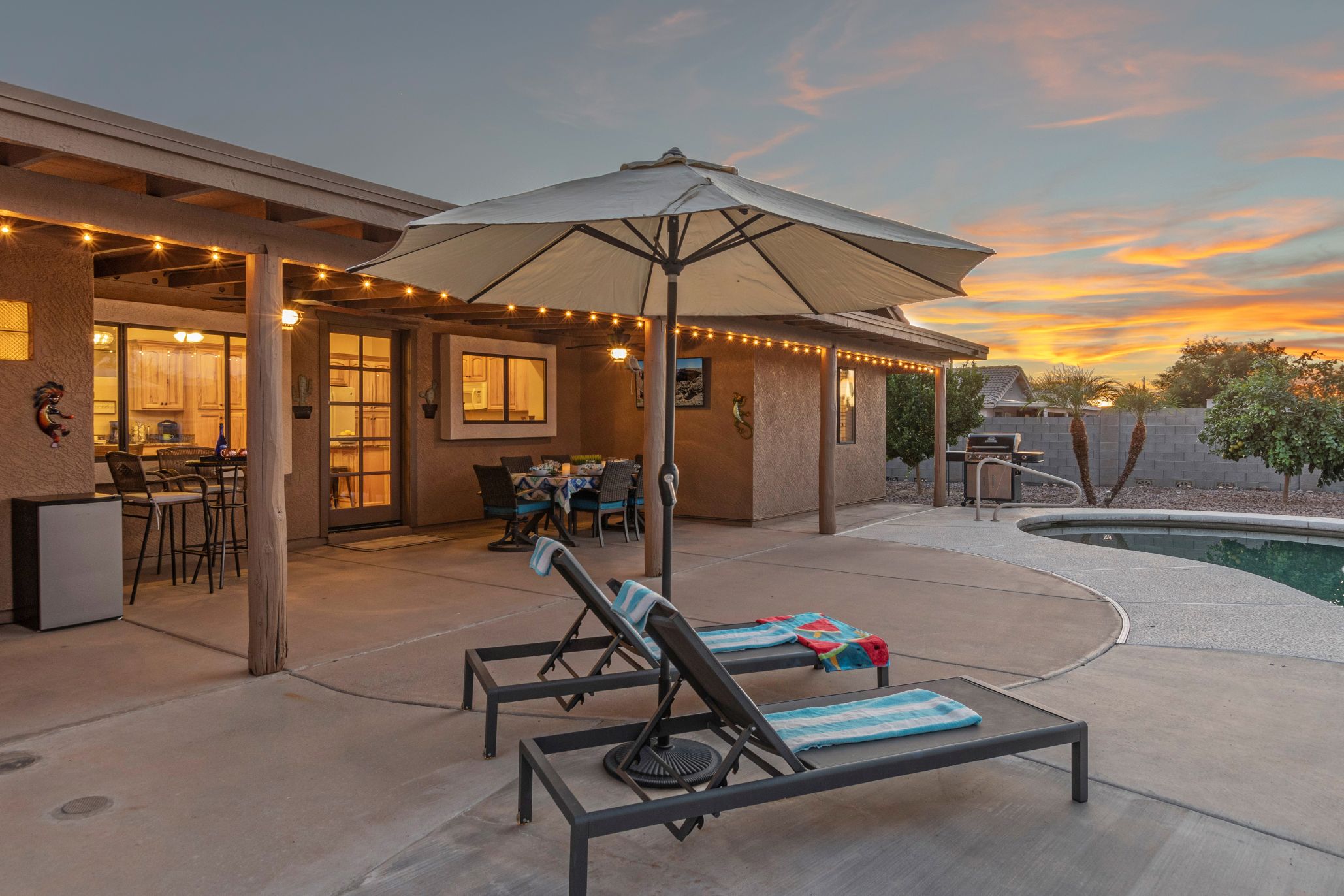

What’s New & Different at Arizona Vacation Home Rentals
We have two new properties we’re excited to showcase. All that’s missing from these dream come true vacation homes is YOU! For more information or to book, visit Arizona Vacation Home Rentals. Booking directly at Arizona Vacation Home Rentals saves you money and supports local business.
Our first, newly acquired home is Golden View, a 5 BR, 3.5 BA, single story, Gold Canyon home. Love our Superstition Mountains? They are the golden view from the backyard and many of the interior windows. The resort amenities at this gem include a heated pool, hot tub, covered patios for dining or watching TV and a gas fireplace. The interior of this home is luxurious throughout with a theater room featuring a gas fireplace and TVs in 4 of 5 bedrooms. To spend time at our dream come true vacation home book now at Arizona Vacation Home Rentals and then start packing!

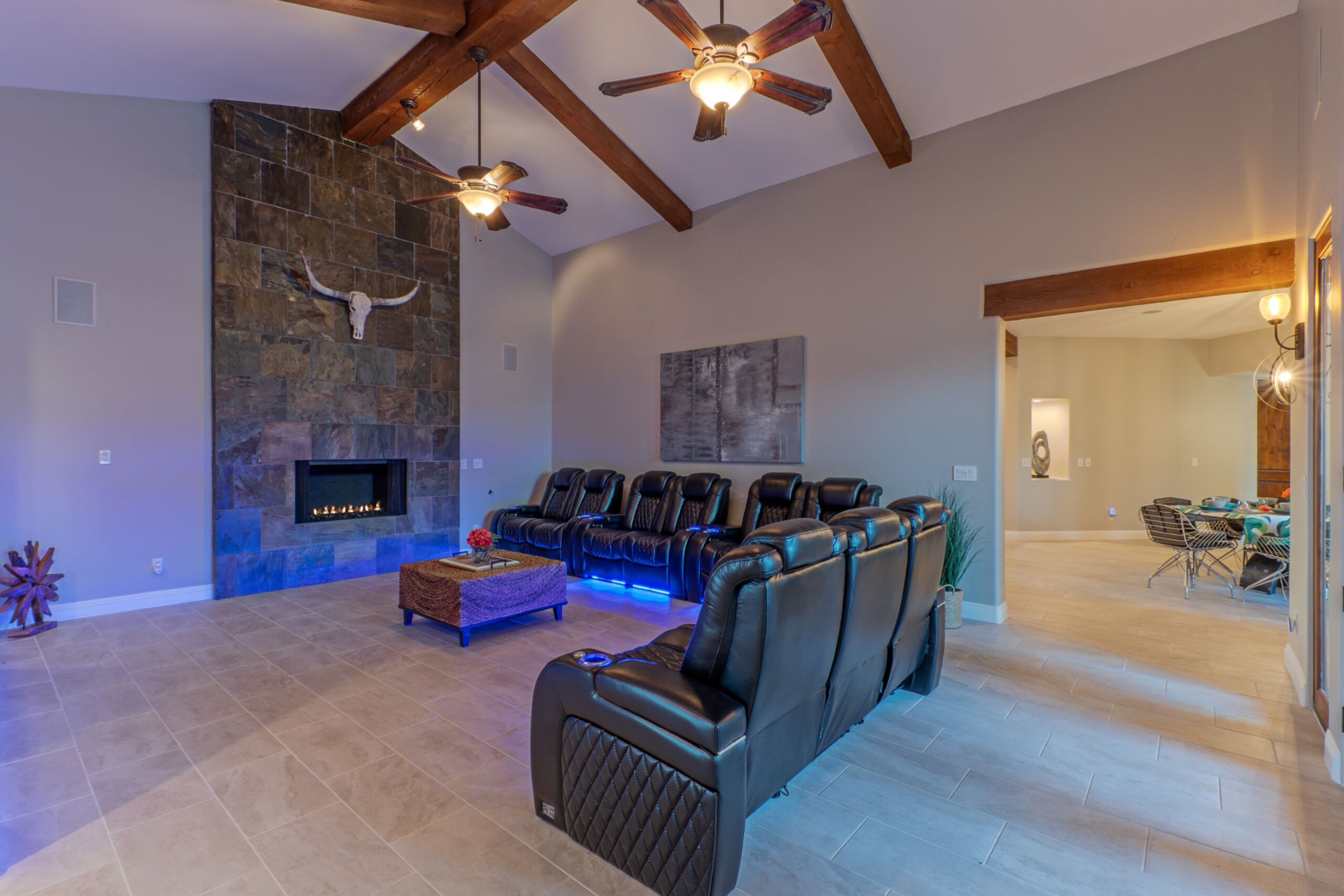

♦♦♦♦♦
The second of our new homes, but not second best in any way, is Adobe Ranch, a secluded 4 BR, 3 BA, single story home on a large lot in East Mesa. The appealing amenities include a heated pool, covered patio and gas fire pit to warm your toes and heart. The charming southwestern decor in well appointed rooms is both attractive and comfortable. The property’s location is ideal for guests who enjoy golfing, hiking, biking, kayaking, Chicago Cubs spring training, shopping or dining out. Visit Arizona Vacation Home Rentals to see all the wonderful details and book your exciting vacation! Booking directly at Arizona Vacation Home Rentals saves you money and supports local business.

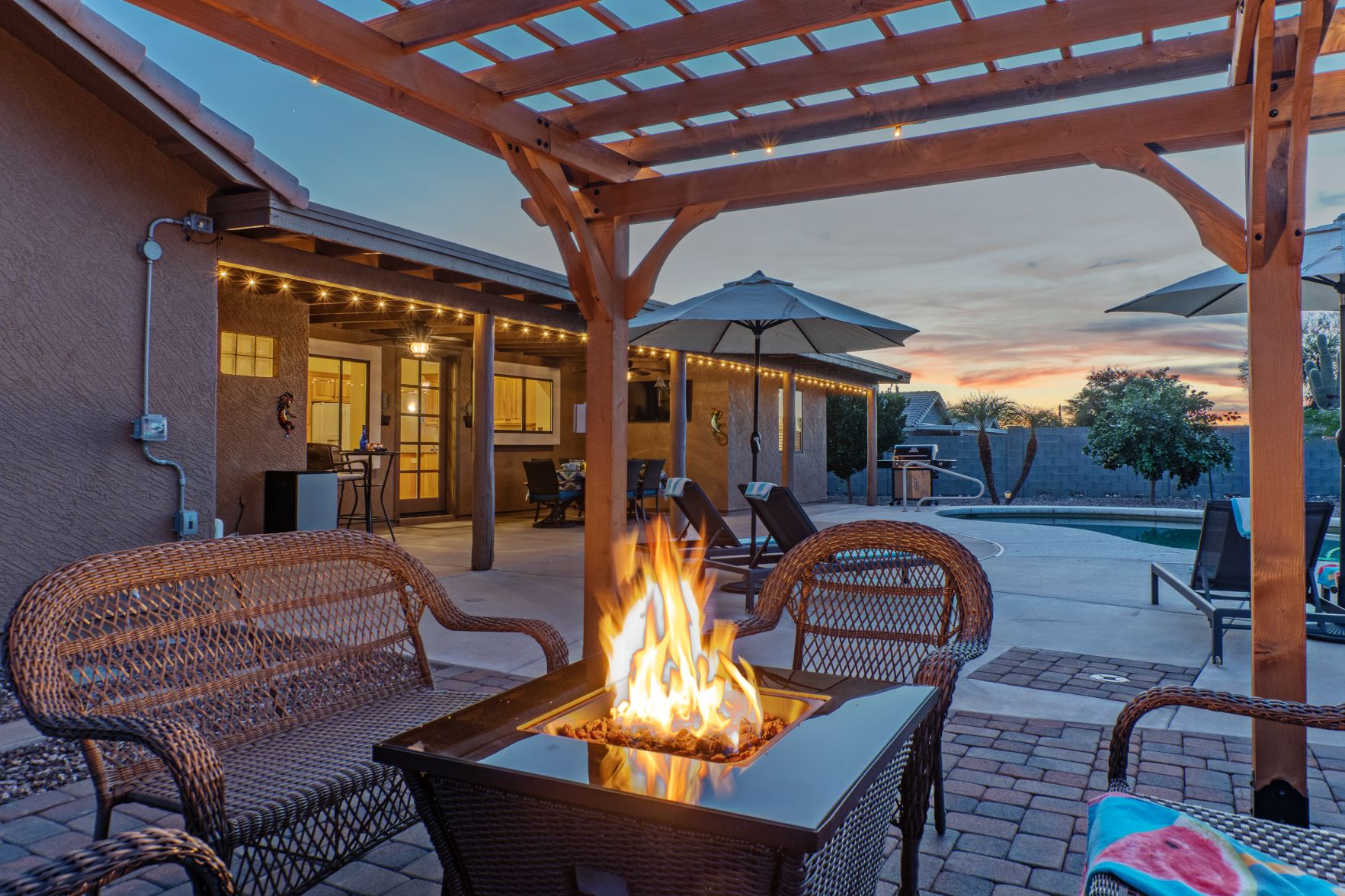
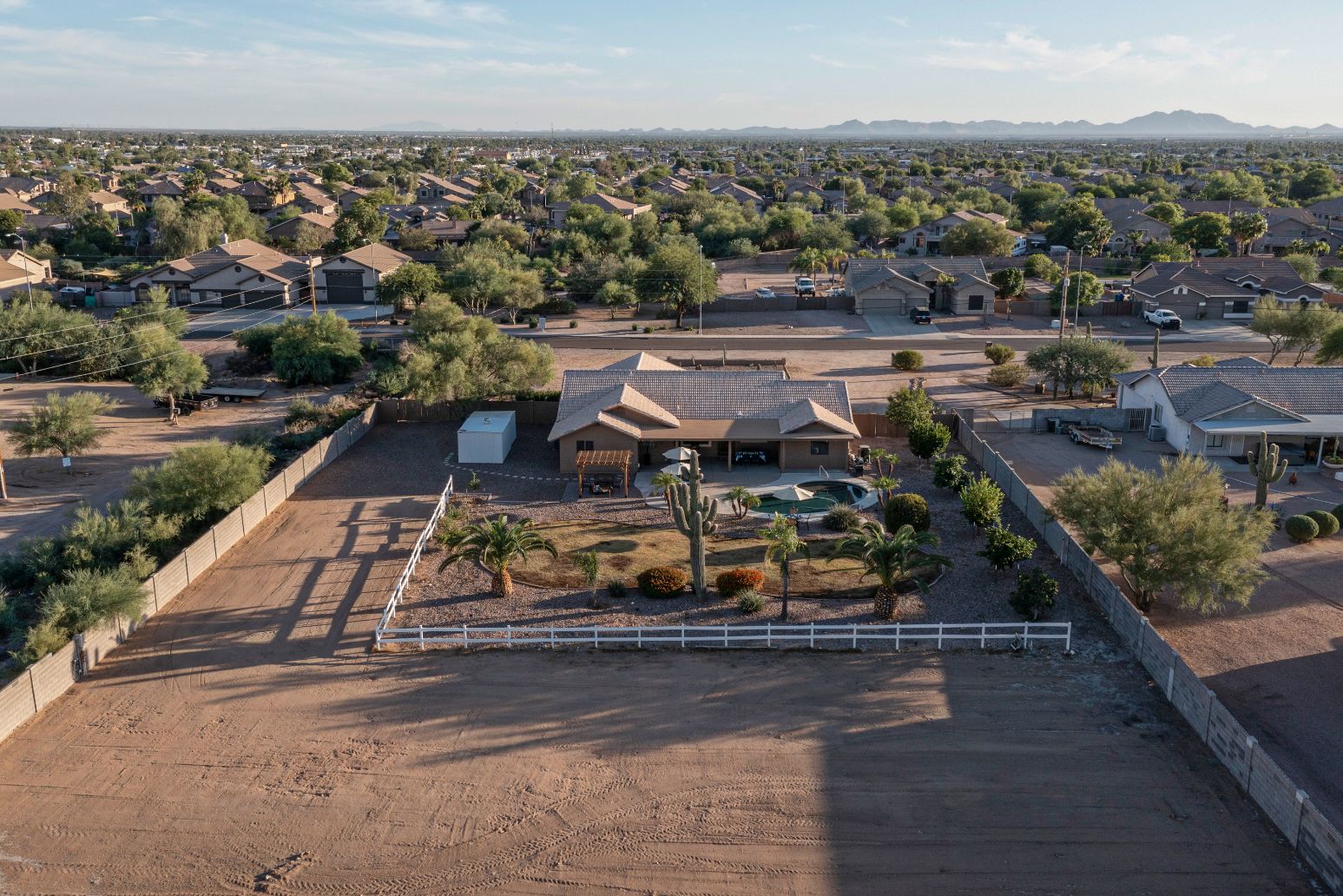
♦♦♦♦♦
Winter Travel to the Greater Phoenix Area
Weather
The fall can be the perfect time to visit the greater Phoenix area. Most days are warm, sunny and ideal for outdoor adventures of which there are many. The chart below features average day and night temps during the fall months.
| Month | Average Day Temp | Average Night Temp |
| December | 67° F | 46° F |
| January | 69° F | 46° F |
| February | 72° F | 49° F |
Packing for Our Winter Months
As you can see our temps are cooler in the winter months. That being said, 300+ of our days are sunny and temps can climb during the daylight hours. Be prepared for the temp changes which can sometimes be dramatic and pack the following:
- Clothing you can layer when temps are cool or warm
- Sunscreen, hats, sunglasses
- Moisturizers to protect against the drying effects of low humidity
- Sweatshirts or jackets for cool days and evenings
- Binoculars, camera gear and field guides
- Insect repellent
- Sturdy walking shoes
- Swimwear if you are renting a home with a heated pool or hot tub
- Recreational gear: golf clubs, bike helmets, tennis and pickleball rackets, etc.
Why Heat the Pool at Your Vacation Home
Guests often ask us if heating the pool at their rental home is necessary. If you read our guest reviews you will learn that pool heat makes swimming in our winter months more enjoyable.
Additional information about pool heat that you need to know:
- Pool heat is available for an additional fee, October through March, at homes with pool heaters. Pool heating is optional.
- We heat our pools to 80°. That temperature might not feel warm enough for some swimmers and especially if the day is cloudy and/or ambient temps are cool.
- You may often choose the days you heat the pool, but it can take up to 3 days for the water temps to reach 80° depending on the ambient temps.
- If nighttime air temps drop significantly, no matter how efficient the pool heater is, the water temperature will drop. Putting solar blankets in place when you’re done swimming each day helps maintain the desired 80°.
Health & Safety
Vacation rental homes are safer than hotels. Our homes are self-contained meaning you have everything you need at the home with the exception of consumable items such as food and your personal effects. We offer no-contact check-in and check-out and adhere to all CDC recommended cleaning practices and employee policies. You’re not sharing amenities such as pools, hallways or dining areas and have absolute control over how you social distance from those not in your bubble.
Currently Arizona has no state implemented restrictions for US travelers from other states. According to CDC guidelines, visitors are encouraged to stay home when sick, avoid close contact with others and wash hands frequently.
Things to Do in the Greater Phoenix Area
Winter months are our peak season. Those who long to avoid freezing winter temps and shoveling snow should escape to the greater Phoenix area. Hikers, bikers and golfers often appreciate our sunny winter days with low humidity and cooler but not brutal temps. Check out our golf blog, Calling All Golfers!, and trail blog, Let’s Hit the Trails, for details on local fairways and trails plus links to the particulars.
Family activities you may find worthwhile are listed below and include links to help you find whatever information you need for an enjoyable experience.
- Arizona is home to the Cactus League’s spring training grounds. The Chicago Cubs is one of many teams who spend the winter and early spring months in Arizona. Read Batters Up for the Cactus League’s Spring Training for fun historical content and helpful links regarding spring training venues and schedules.
- Bearizona is located in Williams and has both drive and walk through tours for viewing wildlife in settings designed to resemble natural habitats. Roads are well maintained and permit you to view wildlife up close from the comfort of your own vehicle. Exciting and educational encounters with bears, wolves, mountain goats and more are always a possibility.
- Butterfly Wonderland offers you a rain forest experience amidst live tropical butterflies and reptiles. Learn about butterfly migration and the importance of protecting pollinators. Watch chrysalis emerge into exquisite butterflies and enjoy the magic of butterfly encounters as they move between feeding stations and greenery. Take a break on Arizona Boardwalk with its restaurants, shops and other attraction venues.
- Looking for a royal treat with jousting tournaments, feasts fit for a queen or king, arts and crafts and interactive entertainment? February 5th marks the beginning of the 34th annual Renaissance Festival and Artisan Marketplace. The festivities at this 50 acre Scottsdale village are held each weekend through April 3 and include free parking.
- If you’ve always dreamed of riding in a hot air balloon, Rainbow Riders in Phoenix/Scottsdale are happy to oblige you. Book a romantic sunrise or sunset flight or enjoy a scenic tour of the Sonoran Desert from a balloon basket.
- Our winter Farmers Markets are where you’ll want to shop for your vacation goodies. Scottsdale, Gilbert, Tempe, Mesa and Phoenix are just a few of the locations where you can purchase fresh grown and even fresh chopped veggies year round. Each market offers unique shopping opportunities and times so check the links to help you plan your market excursion.
Other activities that may coax you to our area include car shows, concerts, theater and sporting events. For example, upcoming events at The Orpheum Theater in Phoenix include A Christmas Carol, The Nutcracker (Phoenix Ballet), Waitress and An Officer and A Gentleman.
Additional fine art venues to check out:
- Ak-Chin Pavilion
- Arizona Financial Theater
- Celebrity Theatre
- Centennial Hall
- Marquee Theatre
- Mesa Ampitheater
- Mesa Arts Center
For our sports loving guests there are year round events to keep you entertained. Below are links to professional teams in the immediate area.
Professional Sport Teams
Football: Arizona Cardinals
Baseball: Arizona Diamondbacks
Basketball: Phoenix Suns
Hockey: Arizona Coyotes
Thank you in advance for reading our newsletter. We hope you will pass on to friends and family who are interested in a vacation rental in the greater Phoenix area. Our spring newsletter will be published in February.
Save money and support local business by booking directly through
Arizona Vacation Home Rentals
Phone/Text: 480.626.4072
By providing links to other sites, AVHR does not guarantee, approve, or endorse information or products available on these sites.
The smallest bird you’ll observe zipping around or hovering within gardens and parks in the Sonoran Desert is the hummingbird. Southeastern Arizona hosts more than a dozen species of hummers as year round residents, seasonal visitors or accidental tourists during migration. Their wing speed of 80 beats or more per second is remarkable which, along with their flapping tail feathers, accounts for the buzzing noise you may hear as they flit between nectar supplies. Nests are crafted of lichens intertwined with spider webs and well camouflaged. Broods are usually 2 eggs, occasionally 3.
Don’t be fooled by the size of these tiny, fairy like birds sporting iridescent colors and pointed bills. At feeders and darting among tube shaped flowers they are territorial and warrior-like, defending food sources, nests and potential mates with their dagger like beaks. Scrappy and relentless, they are capable of flying up, down, backward and sideways. Many species are also proficient at flying thousands of miles along migration routes between Alaska and Mexico or Central America.
Hummingbirds You’ll See in the Greater Phoenix Area
There are 7 hummingbird species commonly viewed in the greater Phoenix area:
- Allen’s
- Anna’s
- Black-chinned
- Broad-tailed
- Calliope
- Costa’s
- Rufous
I will tempt you with interesting and fun trivia about each of these plus suggest local habitats where you are likely to find the species. For more detailed descriptions, photos of both male and females and additional fascinating facts, consult a bird guide or websites that feature hummingbirds and their characteristics.
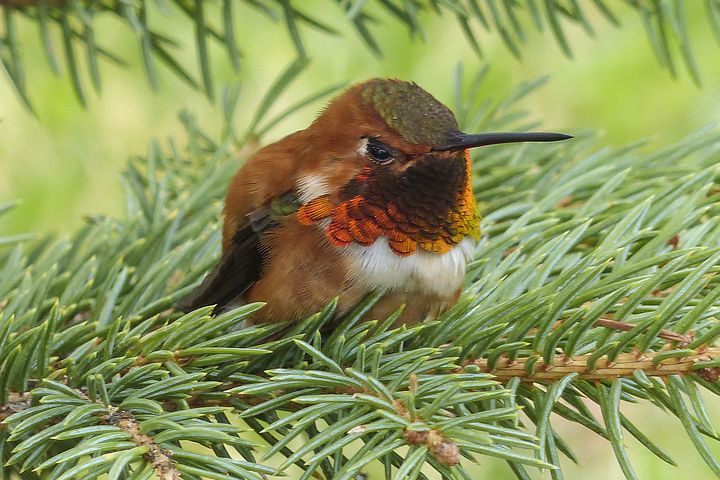
Allen’s Hummingbird
Allen’s Hummingbird breeds along the Pacific coast and is typically viewed in our area only when migrating between western California and Mexico in the spring and fall. They are small, chunky birds measuring about 3.5 inches or 9 cm long and sport shades of copper, orange and green. Males have a distinct red-orange throat and emit a bee-like buzz with their wings. In addition to drinking flower nectar, these hummers flycatch or pluck insects from plants with their straight bills.
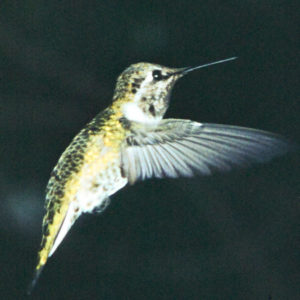
*Anna’s Hummingbird
Once common to the Phoenix area in winter only, Anna’s Hummingbird has increased both visiting and breeding numbers in Arizona in early spring and late fall, making it one of the hummingbird species you are most likely to see in the Phoenix area. Partial to desert scrub and riparian woodlands, this hummer is also a frequent guest in residential gardens and especially those with exotic plants. Whereas many hummingbirds are vocally silent, these males are unique in their ability to make sounds that are musical in nature. Highly territorial, the males also do elaborate aerial dives ending in tail-produced popping sounds to deter intruders such as other birds and people. Anna’s Hummingbird is one of the larger hummers in the Phoenix area yet is considered a medium-sized, slightly stocky hummer. Grey-green in color, males are distinguished by an iridescent red-pink head and throat.
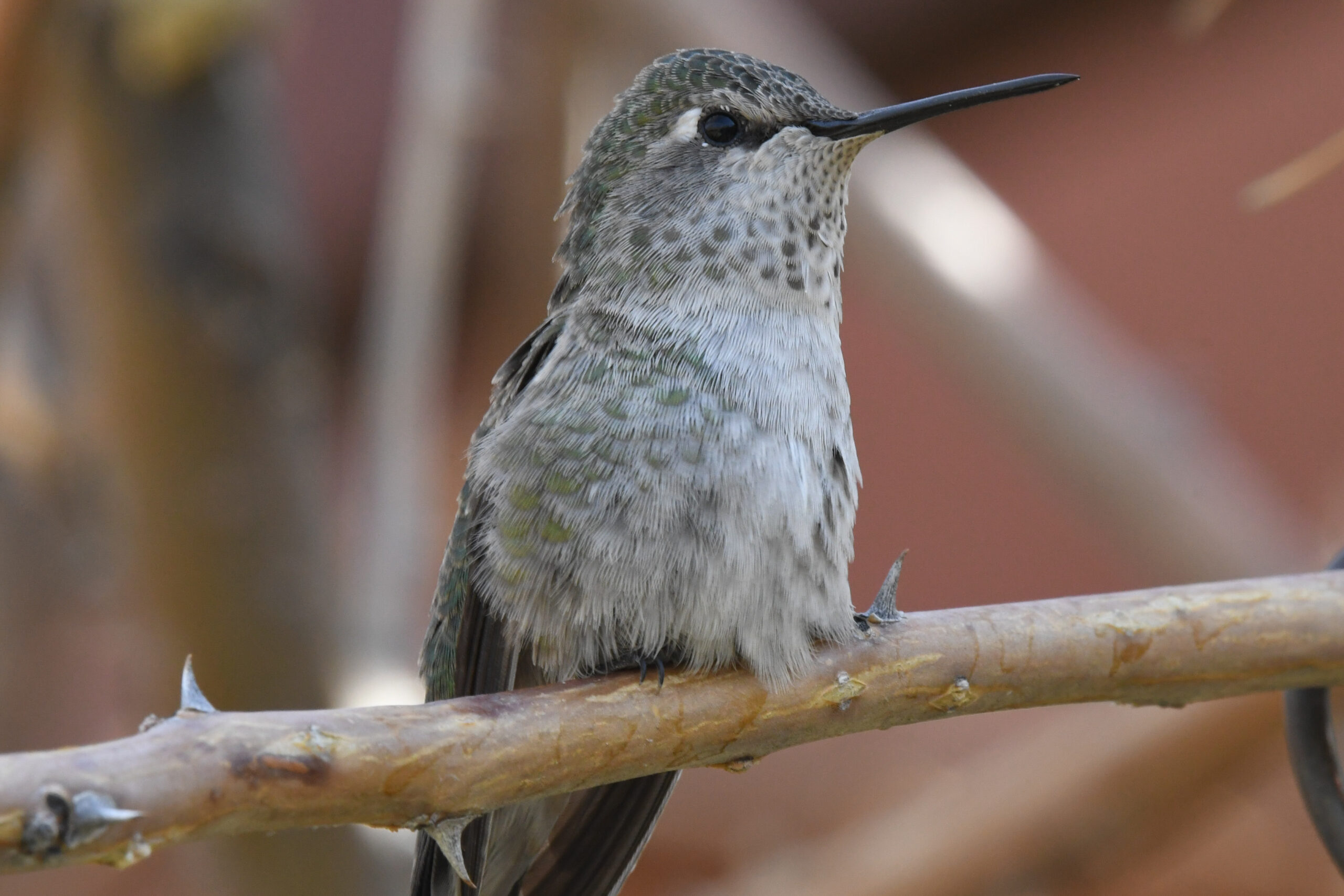
*Female Black-chinned Hummingbird
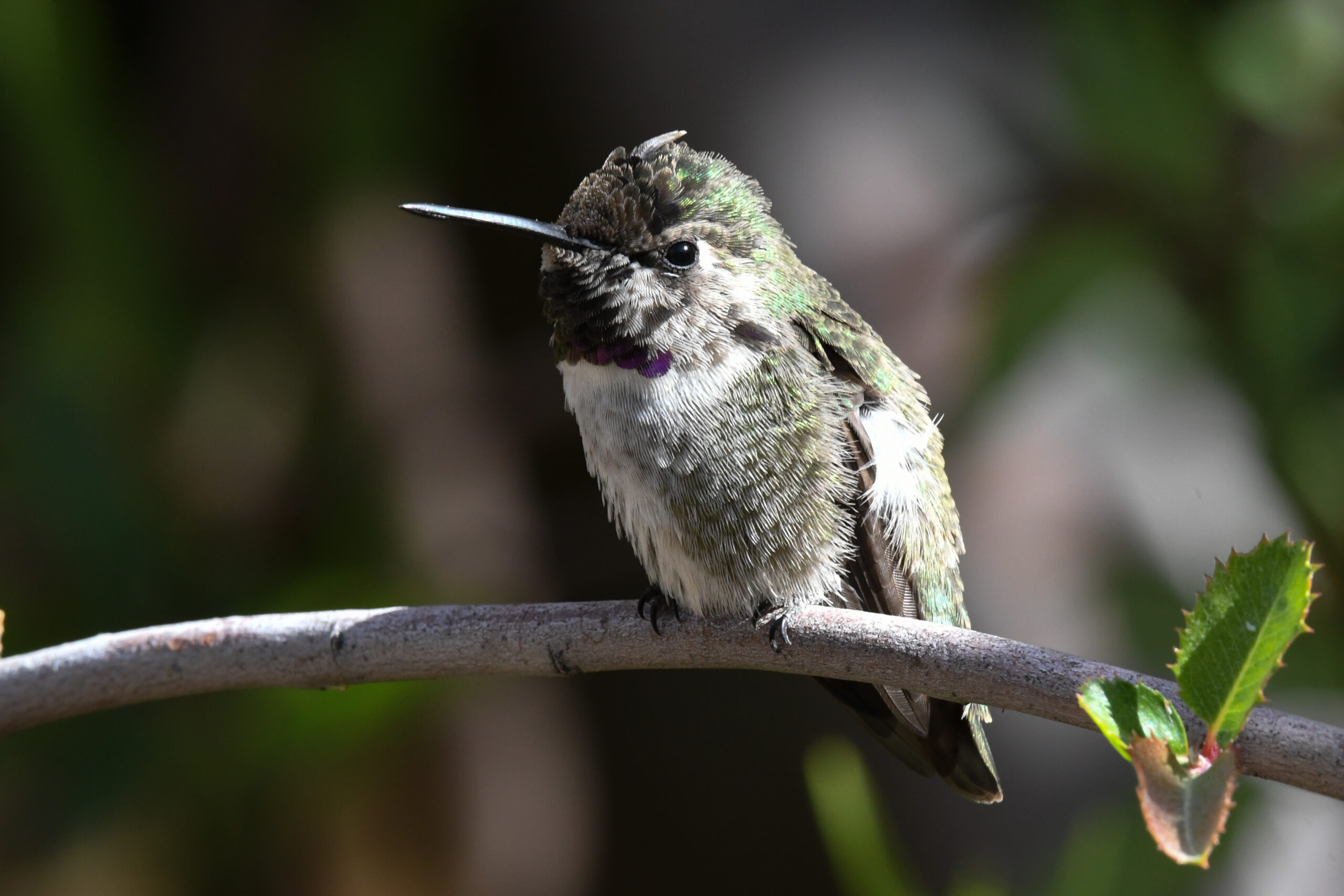
*Male Black-chinned Hummingbird
The Black-chinned Hummingbird is a summer native to Arizona, arriving in March or April and departing in October to spend winter in Mexico. They are highly adaptable and common in middle and lower elevations choosing habitats of deciduous woodlands, canyons, meadows, orchards or cities with flowering trees and shrubs. Similar to the Allen’s Hummingbird in length, they are more slender with an almost straight black bill. Males have a dark throat edged in purple; female throats are pale. Both males and females have muted green back feathers and dull grey chests. They are often spotted on high tree snags when they aren’t zipping erratically between nectar sources. They are frequent visitors to feeding stations throughout the greater Phoenix area. Males use aerial display flights which include 70-100 feet pendular dives to attract females or defend their territories.
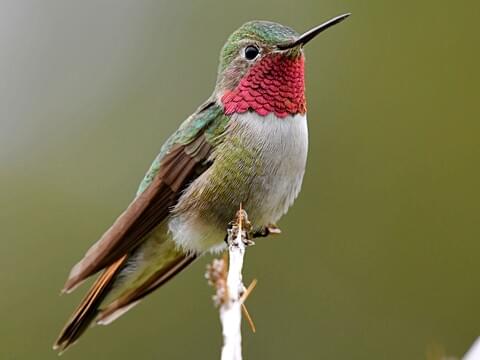
Broad-tailed Hummingbird
Another native to Arizona is the Broad-tailed Hummingbird which typically arrives in late spring and returns to Mexico at the end of September. Breeding habitats include higher elevations on the fringe of pinyon-juniper, oak, pine and evergreen forests. Males make audible metallic chirps with their wings as they dart between blossoms and perform rapid aerial dives. Adorned with noticeable iridescent green on dorsal parts and white chests, their tails flash white tips when in flight. Females and young hummers have green spots on their throats; males sport a magenta-red throat patch. Considered to be a medium size hummer, they have slender bodies and big heads (relative to other hummingbird species).

Calliope Hummingbird
The smallest of the hummingbirds in our area and in the United States is the Calliope Hummingbird with its relatively short tails, wings and bills. Displaying metallic green on their heads and upper parts, both males and females have white or buff breasts. Males are easy to distinguish because they have long streaks of purple-magenta feathers down their necks and perform impressive 100 foot, U shaped aerial dives during courtship. These birds may be tiny but are fierce during the breeding season and have been observed pursuing much larger birds in defense of their nests and mates. They spend winters in Mexico but travel through Arizona in the spring enroute to their breeding grounds along the Pacific coast. Similar to the Allen Hummingbird, the Calliope sips nectar from plants and is a flycatcher of insects.

*Male Costa’s Hummingbird

*Female Costa’s Hummingbird
The Costa’s Hummingbird chooses desert and sage scrub or chaparral as a preferred habitat and drinks nectar from different desert plants such as ocotillo and chuparosa. Their breeding season falls mainly between late winter and spring and to avoid Arizona’s hot summers they then migrate to the coast of California. The female is the nest builder and chooses shrubs, small trees and occasionally a cactus or yucca for the nest site. These are small, compact hummers with a short tail and stooped presentation when perched. Males feature a remarkable purple-amethyst gorget atop their heads and along their necks that conveys a mustached appearance. Both males and females have green backs and white underparts. Known to be more reticent than other hummers, they are likely to visit your feeding stations if you have more than one nectar source available.

Rufous Hummingbird
Last but never least is the bold and territorial Rufous Hummingbird, a common visitor to Arizona hummingbird feeders during their long migrations between Alaska and Mexico. In areas where there are nectar rich flowers and feeders they may stay for a week or two to rest and bulk up for their arduous travels. Unfortunately, Rufous Hummingbirds may discourage other hummers from visiting your feeders as they are naturally greedy and will chase competitors away. Males are orange-brown in color; females are green-orange. They choose desert scrubs, mountain meadows and other locations with flowers and feeders for their migratory habitats.
Feeding Hummingbirds
Hummingbirds require a significant amount of nectar to maintain their high metabolic rates. You can attract resident and transient hummers to sip in your presence by hanging specialized feeders filled with nectar and planting native tubular flowers in yards and parks. Red seems to be a favorite flower color although my hummers also frequent pink, yellow and purple blossoms. Native Arizona plants such as trumpet creeper, lupine, salvias, penstemon, Columbine and bee balms are a source of rich and natural food for hummers. Hummers also consume and feed insects to their young so avoid using insecticides in your yard. Nearby branches or perches for resting between drinks add an inviting touch.
Safe and appealing nectar is easily made by stirring 1 cup of white (not raw) sugar into 4 cups of water and boiling for a minute or two. Please do not add food coloring or dyes which are harmful to hummingbirds and not necessary. Leftover nectar should be stored in your refrigerator. Change the nectar before it gets cloudy and toxic to hummers. Feeders will get moldy relative to the humidity and ambient temps and should be cleaned with mild soapy water, rinsed thoroughly and refilled as needed.
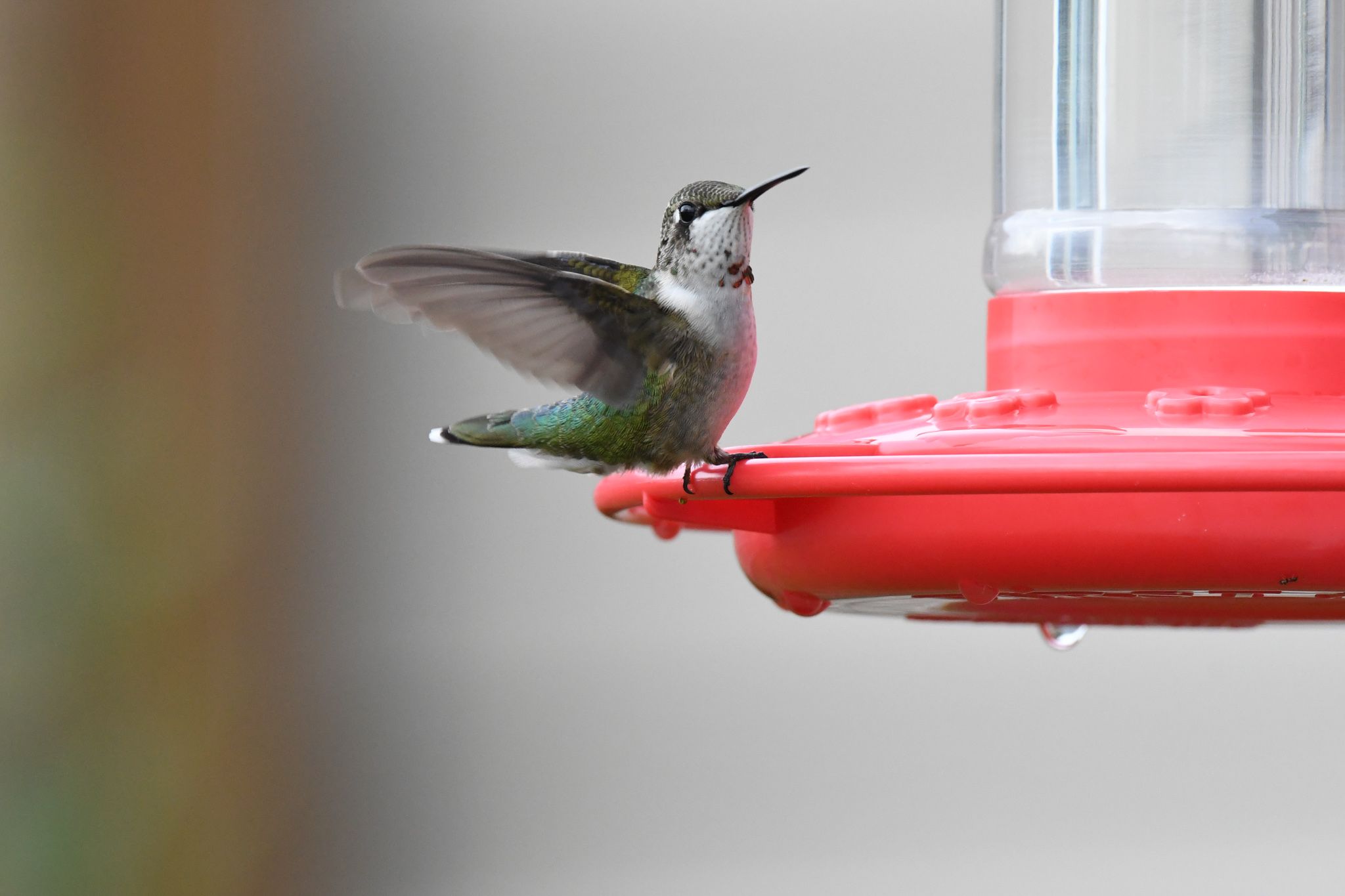
*Uncommon to the Phoenix area is the Ruby-throated Hummingbird
Places to See Hummingbirds in the Phoenix Area
- Desert Botanical Gardens in Phoenix
- Gilbert Riparian Preserve at Water Ranch in Gilbert
- Hummingbird Habitat at Desert Breeze Park in Chandler
- Rio Salada Audubon Center in Phoenix
See Hummingbirds at Arizona Vacation Home Rentals’ Properties
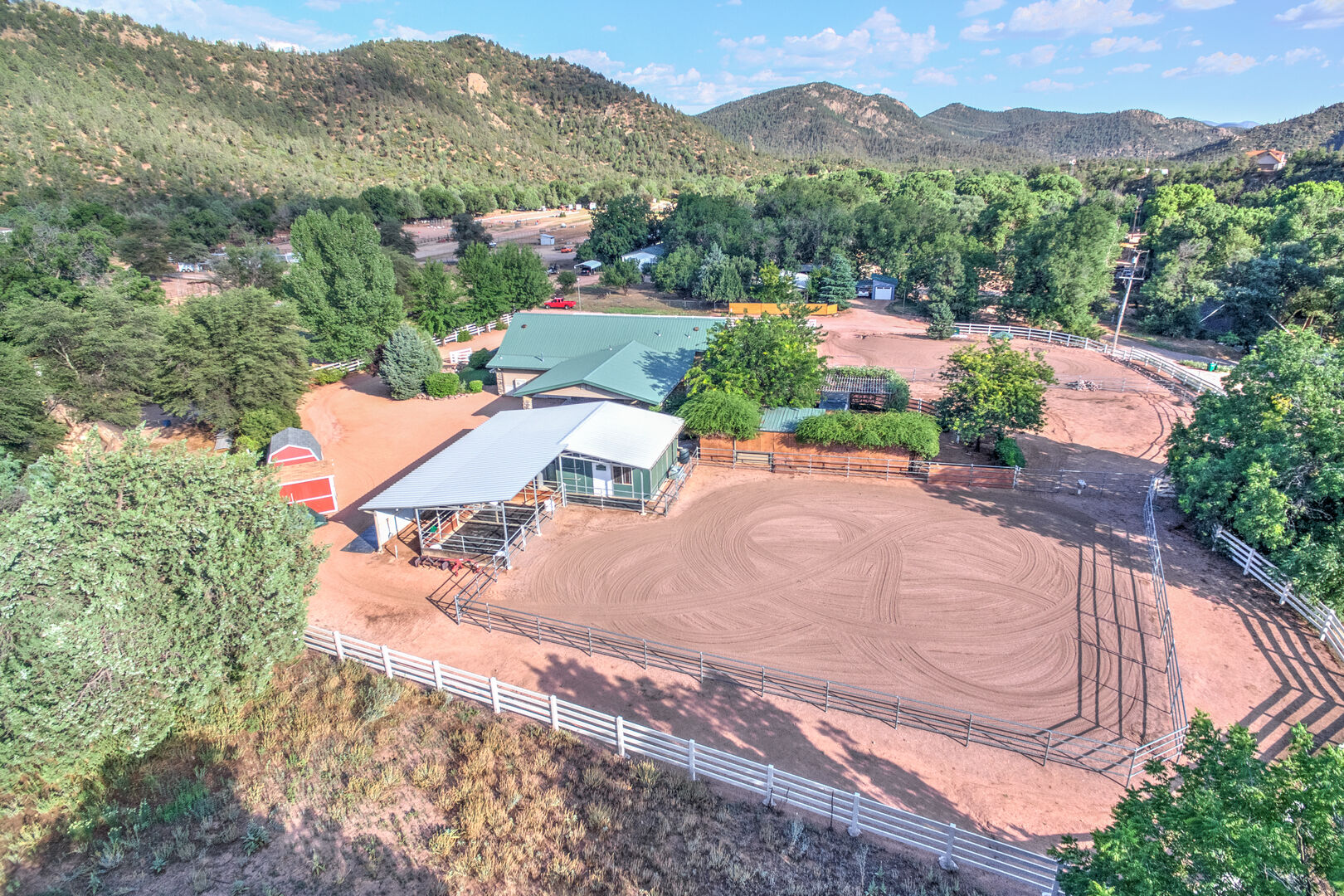
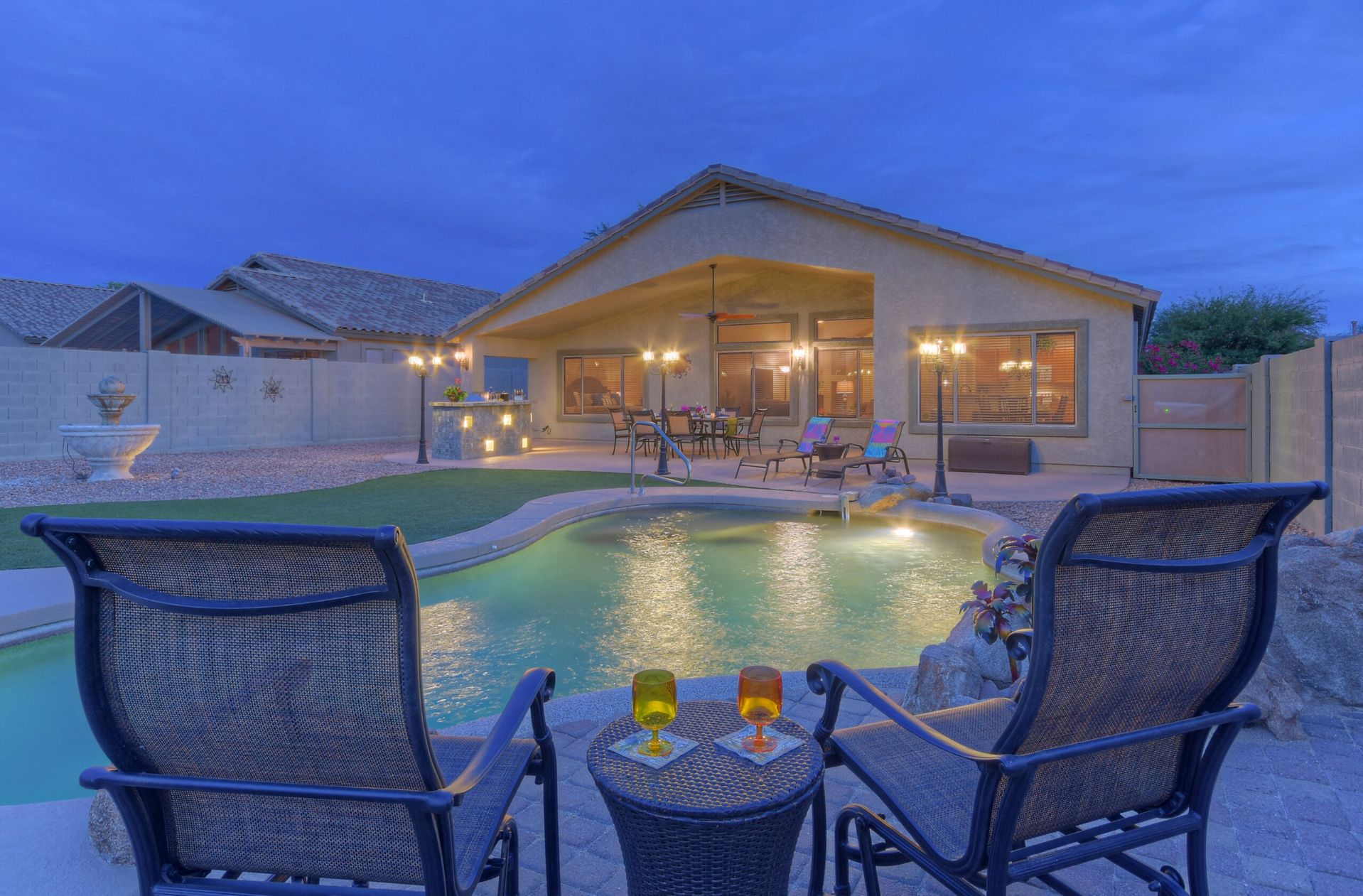
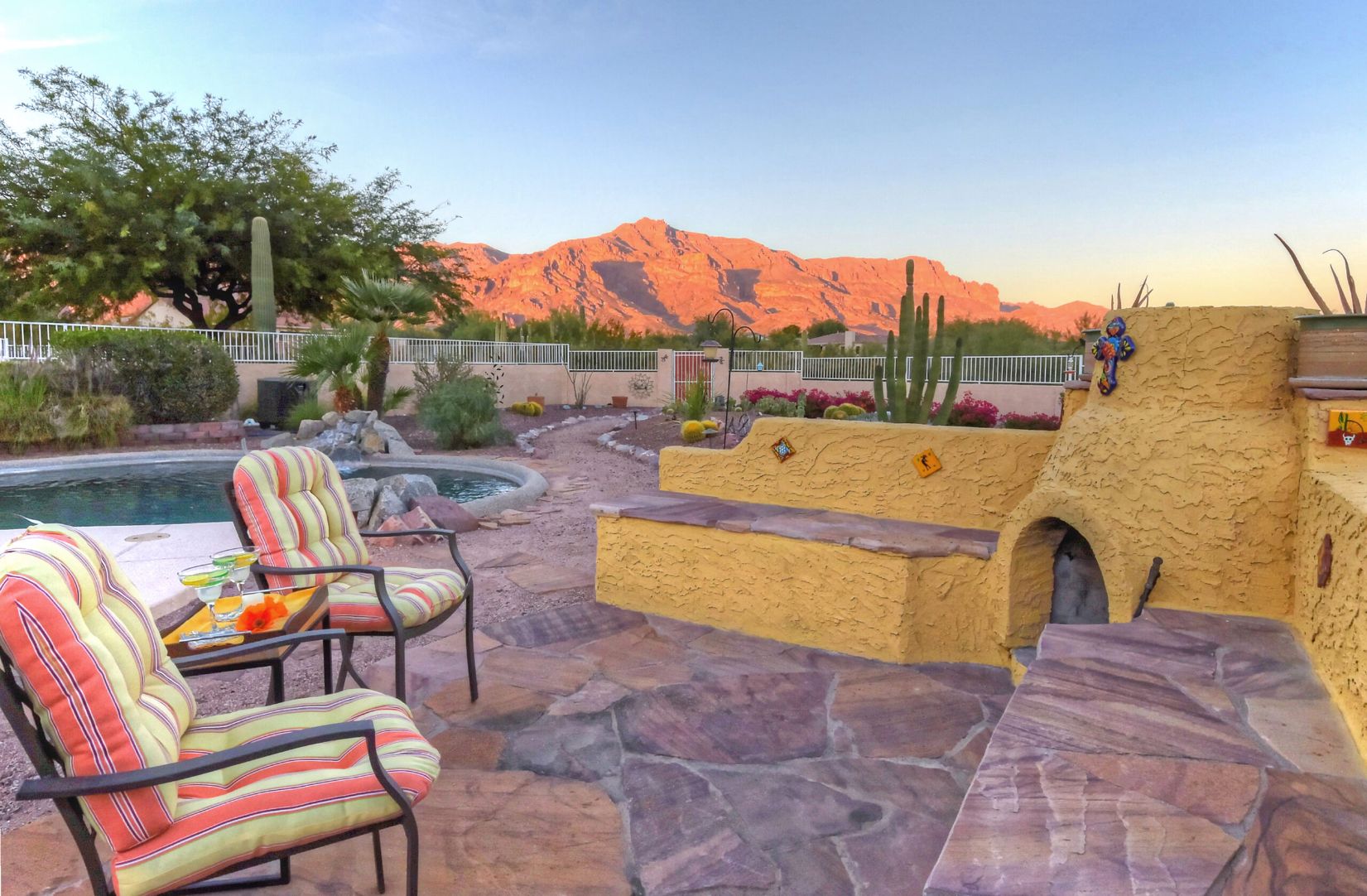

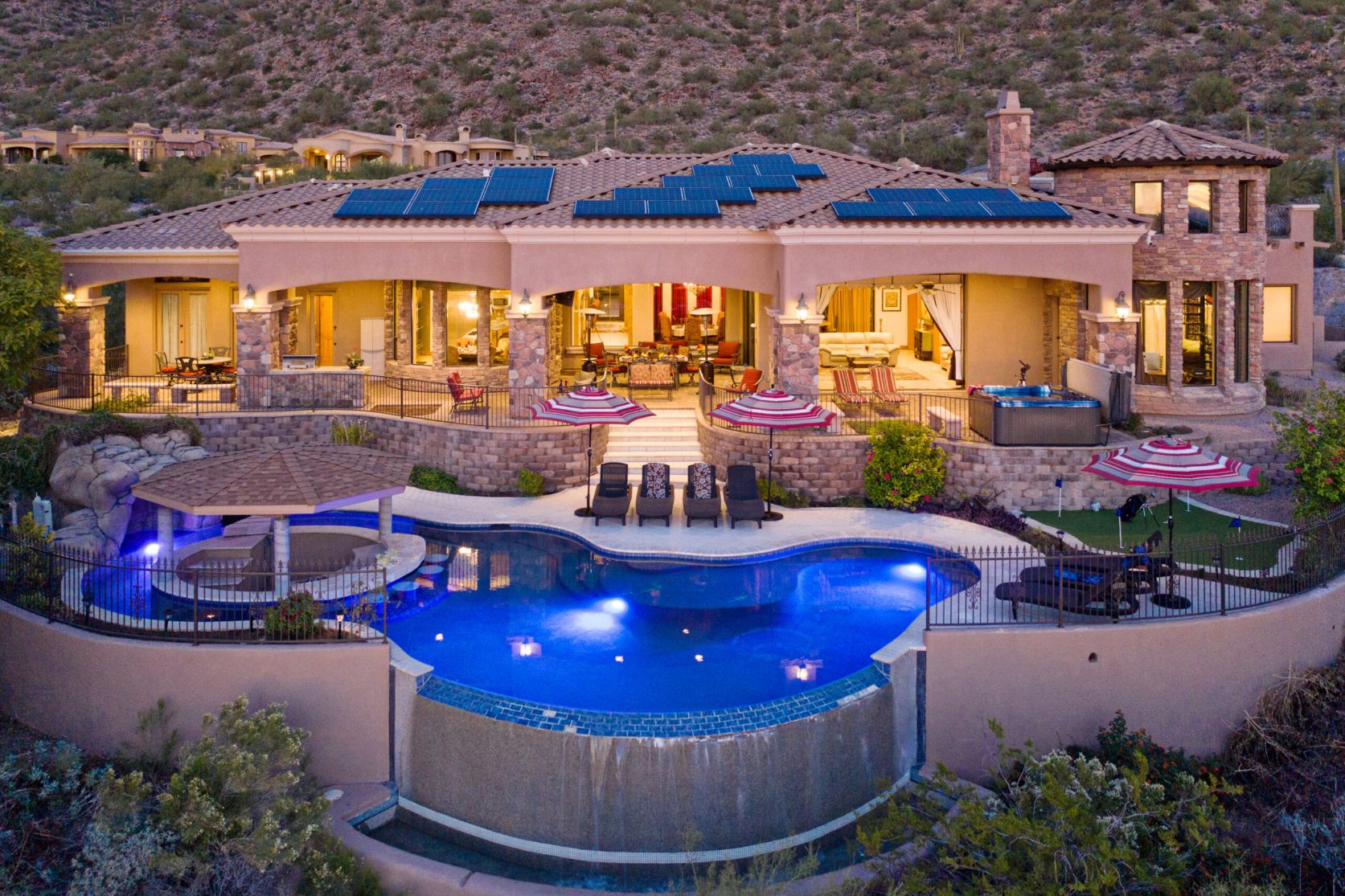
Save money and support local business by booking directly through
Arizona Vacation Home Rentals
Phone/Text: 480.626.4072
*Photo credits: © Gilbert S Grant

AVHR Fall Newsletter 2021
First edition
Welcome! Our quarterly newsletter will give you the scoop on what’s new and different with Arizona Vacation Home Rentals as well as what’s happening in the greater Phoenix area. It will include:
- guest discounts
- details on new listings
- upgrades to our rental properties
- travel tips
- upcoming local events
- links to additional details on related topics
We encourage you to browse and find what you need to customize and plan the perfect Arizona vacation.
Discounts for Booking at Azvacationhomerentals.com
When you’re ready to book ask us about the following discounts:
- 5% discount on nightly rate for returning guests
- 5% discount on nightly rate for veterans with proof of service document
- 10% discount on nightly rate for last minute booking within 3 days of arrival date
- Free pool heat in October at select homes
- Free highchair and Pack N Play rentals in September and October
- Reduced fees for early check-in or check-out on select homes
♦♦♦♦♦
Travel Tips: Phoenix in the Fall
Weather
The fall can be the perfect time to visit the greater Phoenix area. Most days are warm, sunny and ideal for outdoor adventures of which there are many. The chart below features average day and night temps during the fall months.
| Month | Average Day Temp | Average Night Temp |
| September | 100° F | 75° F |
| October | 89° F | 64° F |
| November | 76° F | 51° F |
Health & Safety
Vacation rental homes are safer than hotels. Our homes are self-contained meaning you have everything you need at the home with the exception of consumable items such as food and your personal effects. We offer no-contact check-in and check-out and adhere to all CDC recommended cleaning practices and employee policies. You’re not sharing amenities such as pools, hallways or dining areas and have absolute control over how you social distance from those not in your bubble.
Currently Arizona has no state implemented restrictions for US travelers from other states. According to CDC guidelines, visitors are encouraged to stay home when sick, wear a mask in public settings, avoid close contact with others and wash hands frequently.
Things to Pack
- Sunscreens, hats, sunglasses
- Lightweight clothing in pastel colors
- A sweatshirt or jacket for cooler evenings
- Binoculars, camera gear and field guides
- Insect repellent
- Sturdy walking shoes
- Swimwear and sandals
- Recreational gear: golf clubs, bike helmets, tennis rackets, etc.
Things to Do
Car shows, concerts, wine festivals and more, we have it all. Below are a few events to explore. Check out our blog, Arizona in Autumn? Absolutely! for additional suggestions.
Golf
As the temperatures cool the golfing gets even better. The AZ Golf Association has your need to know information about tournaments in the greater Phoenix area. If you’re looking to play, check out Calling All Golfers! to quickly access links that include the particulars about local clubs and fairways.

Trails for Hiking, Biking and Horseback Riding
Hiking, biking and horseback riding are popular year round but especially as the temps cool. Let’s Hit the Trails includes content related to local trails as well as popular links to help you safely plan your hiking or riding adventures.
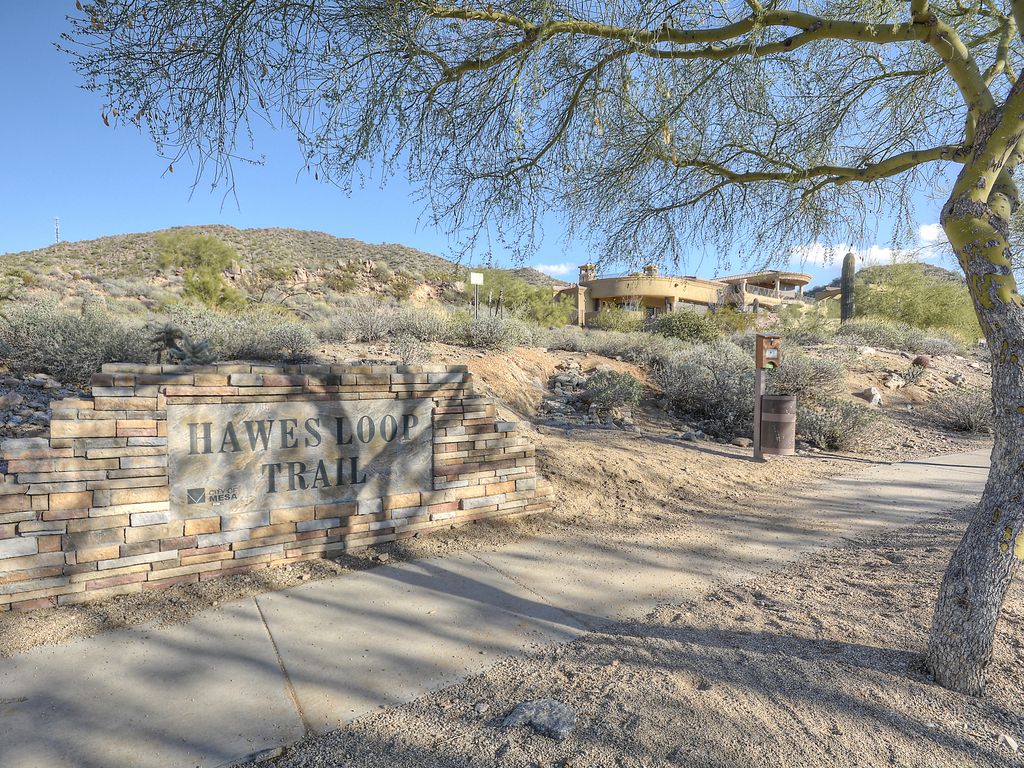
Professional Team Games
Football: Arizona Cardinals Schedule
Baseball: Arizona Diamondbacks Schedule
Basketball: Phoenix Suns Schedule
Hockey: Arizona Coyotes Schedule
Autumn Festivals
•7th Annual AZ Margarita, Mojito, Craft Beer, and Food Truck Festival
Location: Riverview Park in Mesa (2100 W Rio Salado Pkwy)
Activities: Food trucks, Retail Vendors, Live music, Bounce House, Face Painting
Admission: $10 – $40
18 and Under are FREE (Must be 21 or older to receive alcoholic beverages)
•Scottsdale Whiskey Festival – Whiskey Tasting in Old Town!
Location: Wasted Grain in Scottsdale (7295 East Stetson Drive)
Taste whiskeys, bourbons and scotches from around the world
Admission: Tickets are $25 – $35
Location: Queen Creek (20464 E Riggs Road)
Activities: Sip wine and shop among 100+ vendors with a holiday theme and live music
Admission: General admission tickets are $5
•Arizona State Fair
Date: October 1 – 30
Location: Arizona State Fair & Coliseum, Phoenix (1826 W. McDowell Road)
Activities: Live animals, fried food and carnival fun rides for the whole family
Admission: General admission tickets are $12
•2021 Fountain Festival of Fine Arts & Craft
Location: Fountain Hills (Ave of Fountains & Saguaro Blvd)
Activities: Hundreds of arts and craft booths, food and live music
Admission: Free parking and admission
Thank you in advance for reading and please pass on to friends and family who are interested in a vacation rental in the greater Phoenix area. Look for our winter newsletter in November.
Save money and support local business by booking directly through
Arizona Vacation Home Rentals
Phone/Text: 480.626.4072
By providing links to other sites, AVHR does not guarantee, approve, or endorse information or products available on these sites.
By providing links to other sites, AVHR does not guarantee, approve, or endorse information or products available on these sites.

Mesa is the place to be if you’re looking for adventures and activities for the whole family. Check out the Mesa Parks Spring 2023 Activity Guide, Jump In, for classes, activities and special events: https://www.mesaparks.com/sports-programs/activity-guide.
Registration is required for some activities and classes. Most are open to both residents and visitors.
Need a comfortable place to stay? Arizona Vacation Home Rentals has a variety of family friendly homes in the greater Phoenix area which includes Mesa.
Save money and support local business by booking directly through
Arizona Vacation Home Rentals
Phone/Text: 480.626.4072
Diamond Spirit Ranch celebrates the life of Diamond, a gentle, courageous and much loved horse. Of the many animals in the animal kingdom, few compare to the horse with its strength, grace and nobility. Horses often symbolize freedom, invite wild imaginations and manifest power of mind and spirit. Yet when we gaze across a pasture and watch horses grazing peacefully, our heart rate slows as we crave that sense of harmony with nature.
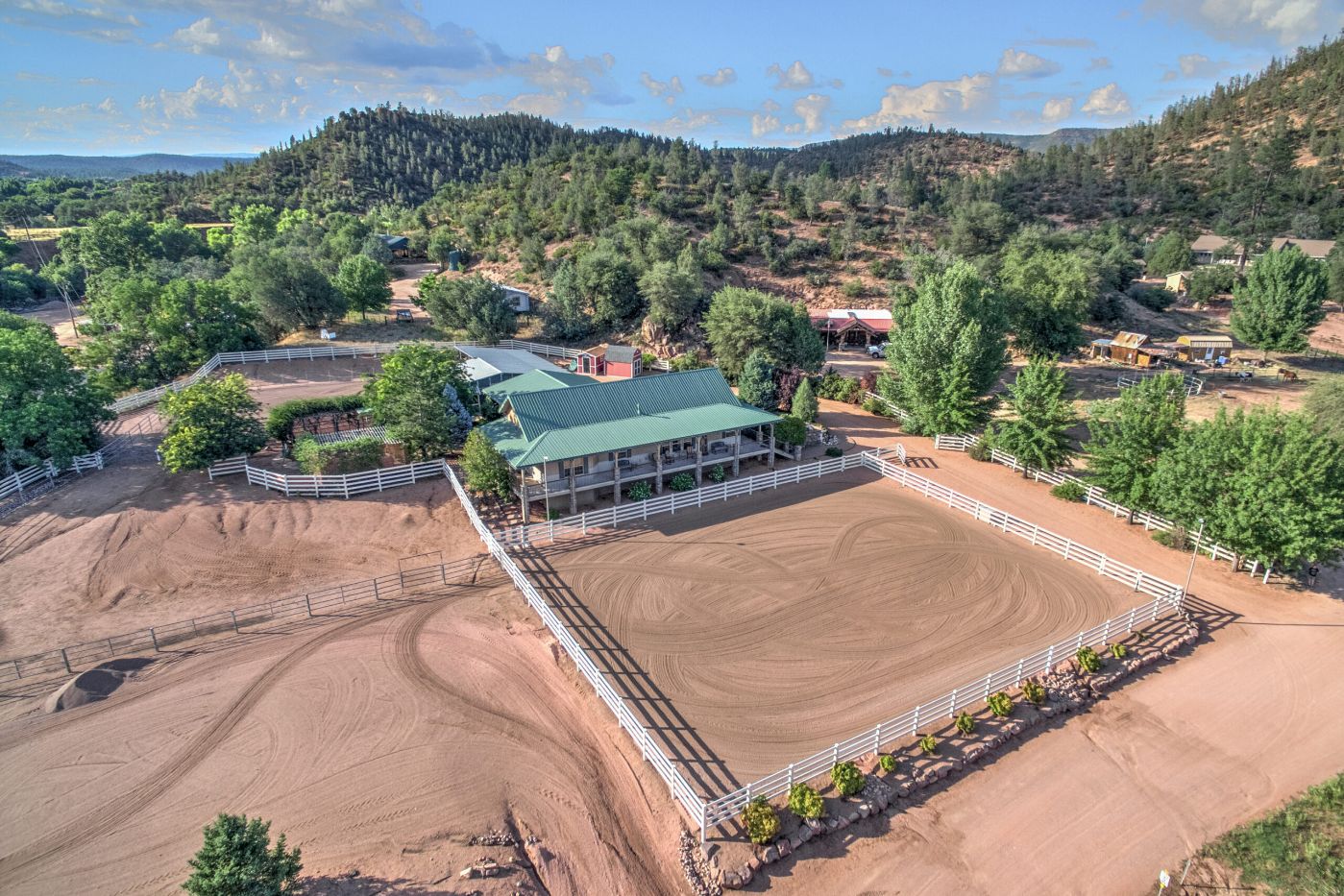
Diamond Spirit Ranch
The Beginning
The story of Diamond Spirit Ranch begins with the purchase of land in Star Valley and the construction of Spirit River Ranch in 1998. John and Sellena Pool, after a frustrating cross country trip with their 2 horses, 4 dogs, 2 cats and motor home, decided to build the equestrian retreat they searched for and never found on their journey. Their vision became providing comfortable lodging and spaces for horses, homes on wheels and their owners with direct access to local trails for trail riding.
John and Sallena fell in love with the Payson area and found what they thought to be the perfect property for their retreat in Star Valley. Star Valley is just outside of Payson and only 90 minutes from the Greater Phoenix area. The property lay next to a dry creek bed and adjoined the Tonto National Forest with horseback riding trails and magnificent Mogollon Rim scenery. The property also bordered Patterson Farm, a riding and boarding facility with a reputation for excellent instruction and tender loving care of horses.
The Pools began construction of their dream home: a ranch house and horse stalls that included turn out paddocks. Space and hookups for an RV were also part of the original creation. Over time a guest house with a tack room, riding arena and an outdoor kitchen with a gathering area were added. Spirit River Ranch was completed in 2000. Sadly, within a few short years, John passed away and eventually Sallena sold Spirit River Ranch to another couple who had future plans to retire and live at the ranch. Several years passed in which Spirit River Ranch remained empty.
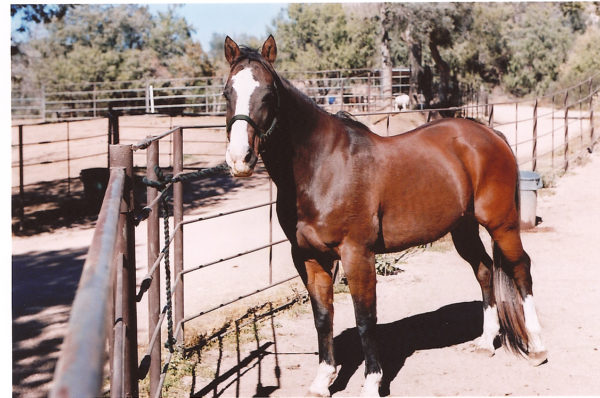
Diamond arrives at Patterson Farm
Diamond Arrives
But wait, my story has galloped too far forward! In the summer of 2006 Tristan, the present day owner of Diamond Spirit Ranch, moved from North Carolina back to Arizona’s Phoenix area. She needed to find a home for her horse, Diamond, a flashy bay quarter horse who would be arriving in October. Word of mouth from other riders is often the best way to locate competent boarding and riding facilities. Patterson Farm was highly recommended and after a few visits Tristan knew the higher elevation, four distinct seasons and cooler temps plus large pastures was the ideal home for Diamond. In October, Diamond made a cross country trip similar to the Pool’s (without the dogs and cats) and arrived at his new home at Patterson Farm.
Tristan lived and worked in Mesa but visited Diamond weekly, driving by Spirit River Ranch to reach the farm. To be closer to her horse, she often rented rooms or homes in Payson and considered inquiring about renting the Spirit River guest house but never did. After several years she acquired another horse who joined Diamond at the Patterson Farm.
By 2018 Tristan, who worked in the vacation rental industry, determined that she could manage her mostly remote work from afar. She and her partner, Paul, moved to a home in Payson so she could be closer to the new mare and her beloved Diamond.
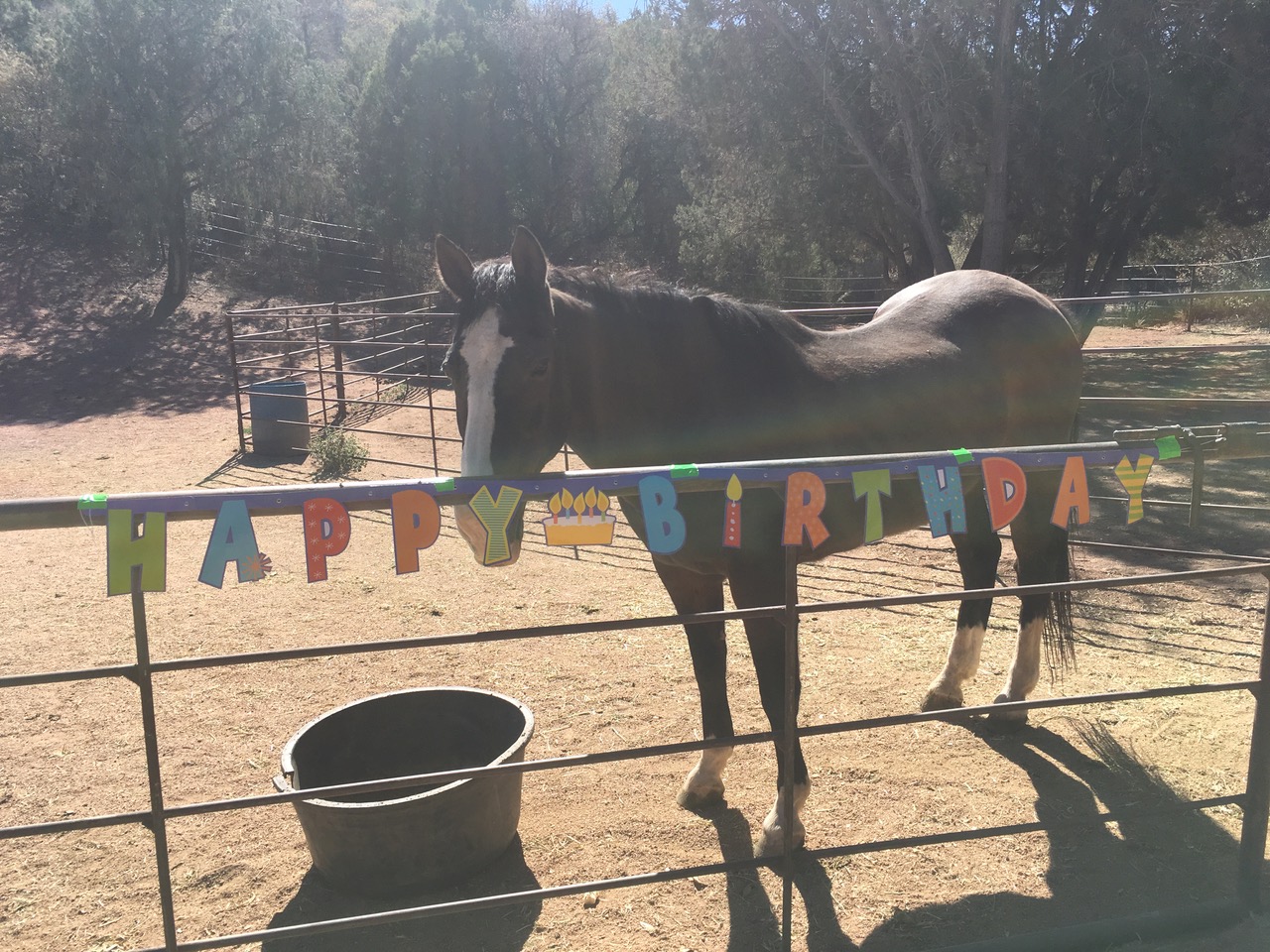
Diamond celebrates his 30th birthday
New Owners; New Name
After 12 years at Patterson Farm, Diamond, a senior horse by all standards, passed away. Losing a horse leaves a big hole in your heart forever but Tristan had a mare to train and ride, thus she continued her almost daily riding excursions to the farm, passing Spirit River Ranch along the way.
In 2019 the owners of Spirit River Ranch changed their retirement plans and put it up for sale. Tristan and Paul arranged to purchase and assume the homestead. Tristan had purchased another young mare and would now be within walking distance of the riding facility that had become her favorite place to spend time. From their new home’s front porch she could view the large riding arenas at Patterson Farm plus she could almost see the turn out pastures of her cherished mares. Paul had longed for a mountain retreat and also felt content at their new ranch.
To know the ones we love are still around in spirit helps to ease the pain of loss. Renaming of the ranch to acknowledge a horse’s ever present spirit seemed logical and Diamond Spirit Ranch became the eponym for Diamond’s legacy.
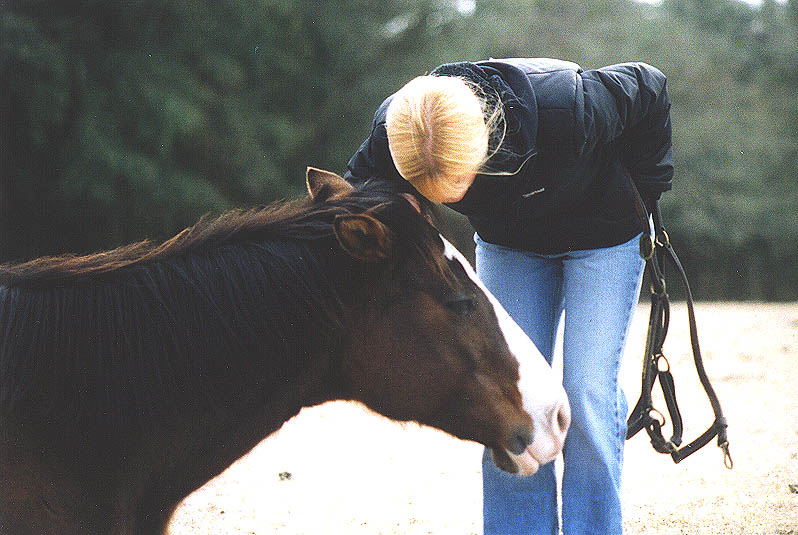
Diamond’s legacy lives forever at Diamond Spirit Ranch
Lingering Spirits
Belief in spirits means something different for all people because spirits are what our senses experience in the natural world, explainable or not. Spirits are forces that shape our actions; they change over time as we adjust to novel experiences amidst new relationships. Becoming open to the energy that spirits require allows us to realize our own qualities as well as the qualities of others.
Spend time at this ranch and you may hear tapping at the windows, an inexplicable creaking of a porch rocker or the soft thudding of distant hooves late at night. Visions may arise in the swirl of pasture dust on a sunny day or in the rock layers of the Mogollon Rim. Open your mind to the spirits that linger here. They have tales to tell, tales that weave a rich and colorful tapestry that is the story and heartbeat of Diamond Spirit Ranch.
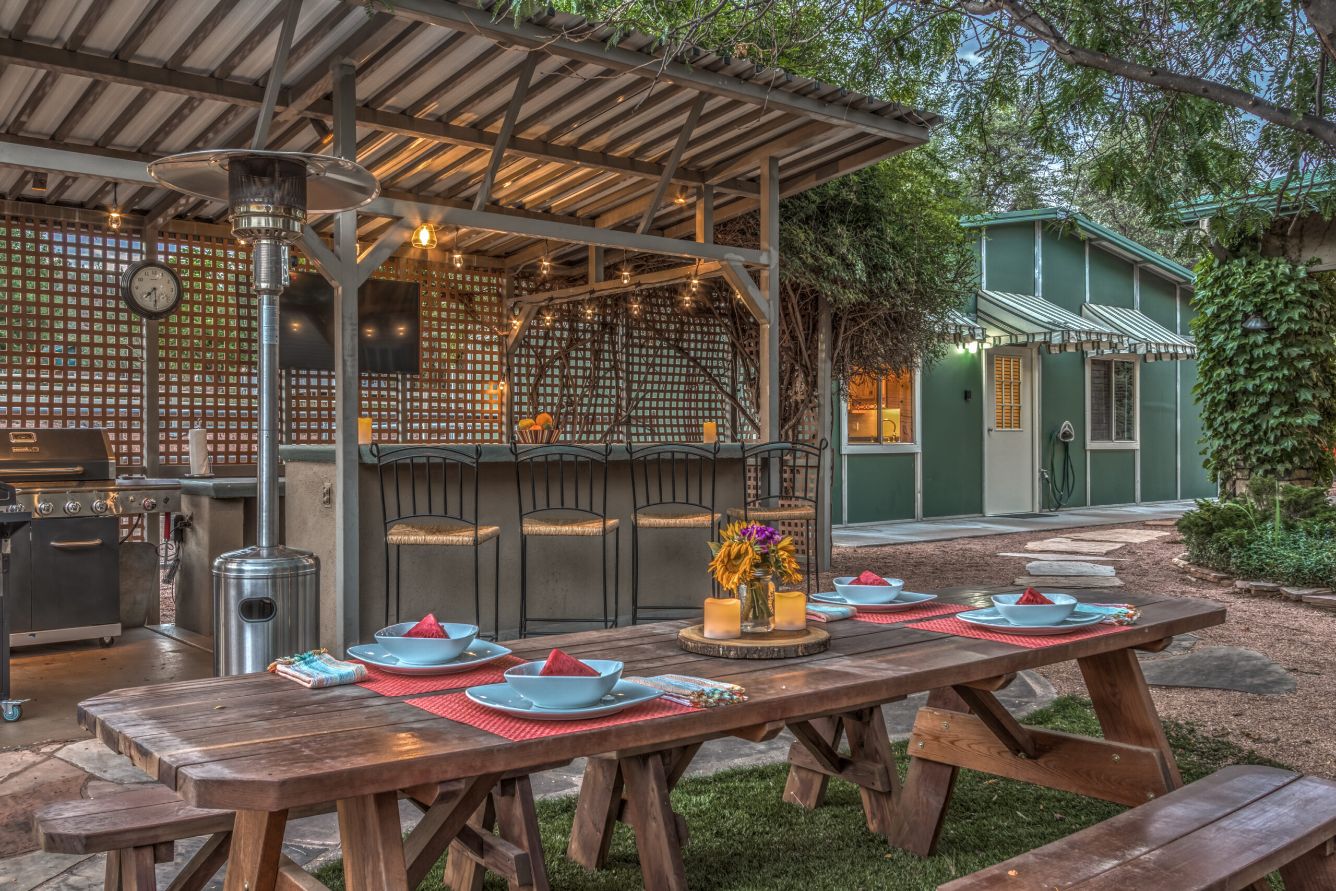
Guest house and outdoor kitchen at Diamond Spirit Ranch

Mountain views from the veranda at Diamond Spirit Ranch
Save money and support local business by booking directly through
Arizona Vacation Home Rentals
Phone/Text: 480.626.4072

Do not dismiss the desert as dusty and barren. The Sonoran Desert is lush with bold and barbed cacti, colorful and fiercely armed to protect the species as well as the water they hold in reserve. While there are many cacti to celebrate, this blog will identify and highlight the features of some of the more common cacti found in Arizona’s Sonoran Desert. Favorite destinations to see a variety of cacti are listed at the end and include helpful links.
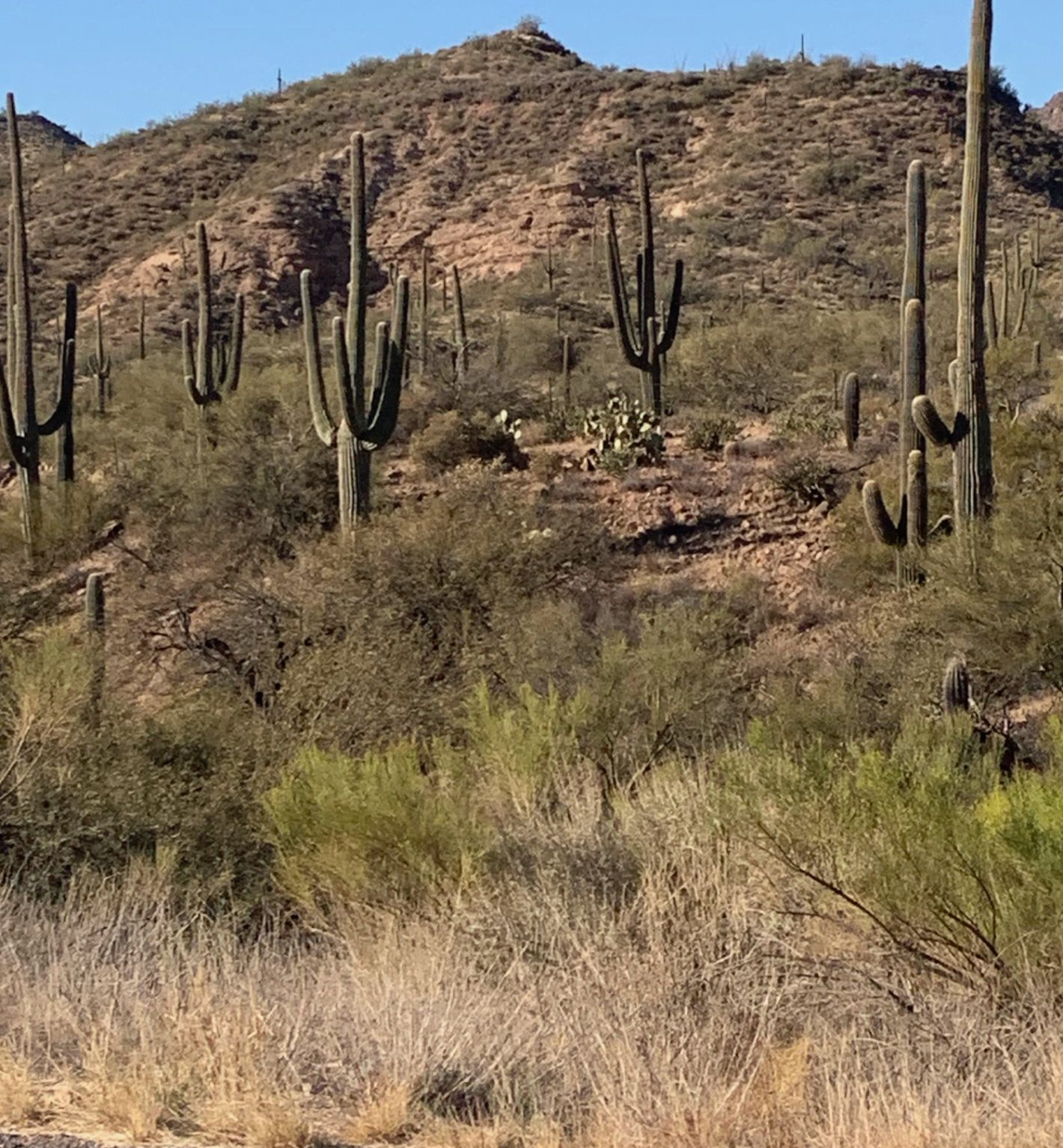
Saguaro Cactus (pronounced suh-wah-ro)
This is the cactus of my cowboy crush days and the symbolic icon of the wild west and southwestern deserts. Commonly and exclusively found in the Sonoran desert, the Saguaro stands erect like a tree or column with extended branches. This is the largest of the cactuses in the USA, growing to be 40-60 feet tall. It is slow growing and has a life expectancy of 150 – 200 years. It may grow 50 years before an arm appears and while some have dozens of arms, a few will remain branchless. It is usually about 70 years old before the first flowers appear. White in color, they emerge each spring followed by red fruit that appears early in the summer.
A tap root that extends 2-4 feet in length allows this cactus to collect a significant amount of water which it stores in its spongy interior. The water adds considerable weight to the trunk and a mature Sagauro can weigh over a ton. The external spines and bristles defend the water reserve from predators allowing the cactus to thrive in the harsh desert elements. Although the Sagauro is not endangered or threatened, it is protected in Arizona.
Teddy Bear (Jumping) Cholla
This is not the teddy bear to cuddle! Although the short, cylinder shaped stems covered in thick golden spines look fuzzy, this could be one painful bear hug. The spines, 1/2 to 1 inch in length and equal in size, 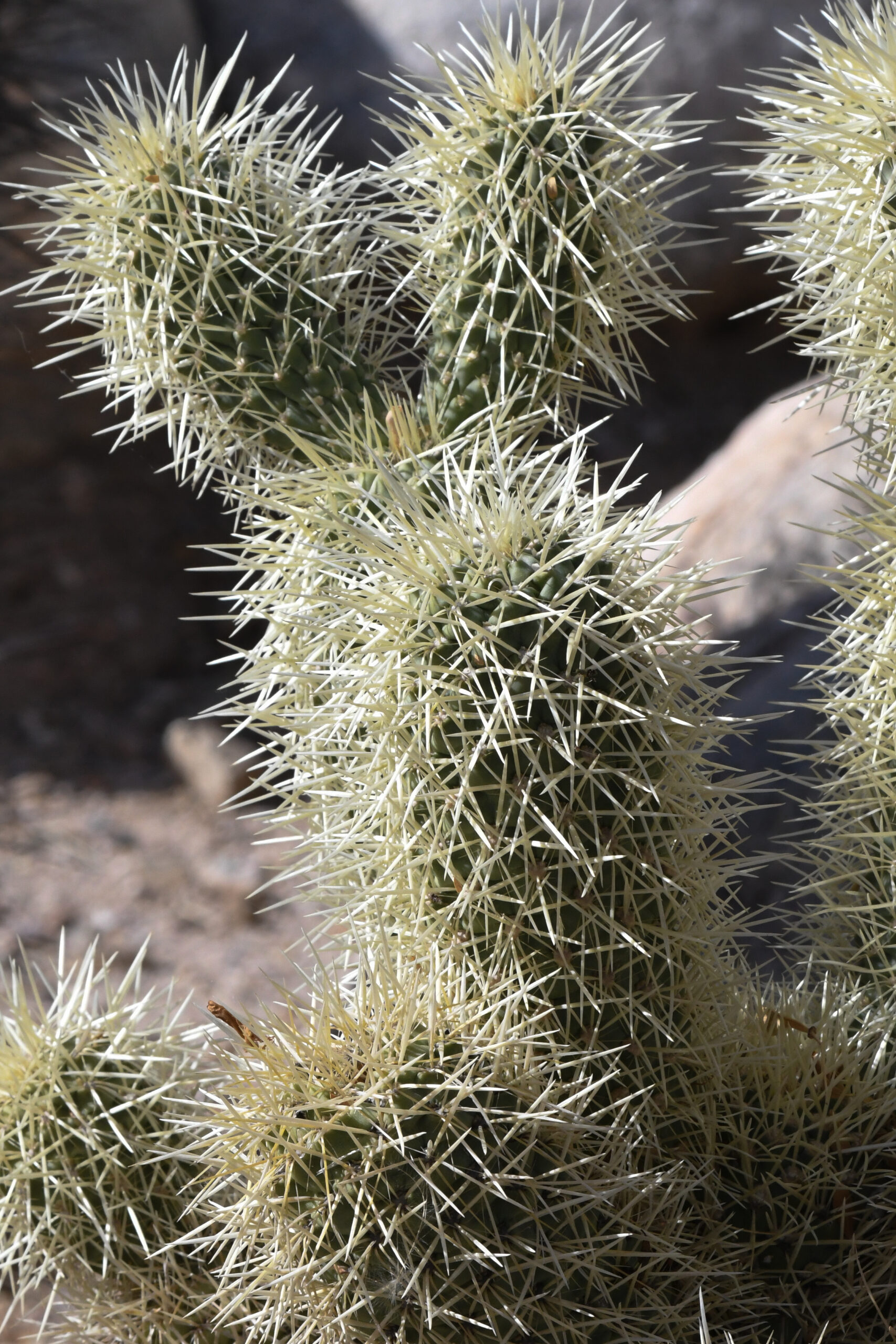 attach with a reversed barb making them difficult and painful to remove.
attach with a reversed barb making them difficult and painful to remove.
Found in California, Nevada, Arizona and Mexico, this cactus grows to be 5 feet and has yellow-green or orange flowers that bloom in spring. The cactus propagates when the stems which detach easily hitchhike on moving objects such as pant legs, socks, shoes and animal’s fur. Wherever the stem segment is deposited, a new cholla will grow.
The formidable spikes keep the plant from being eaten and also protect the water stored within. Dead stems, brown or black in color, often collect at the base of the plant but beware! Even the dead stems and sometimes the fruit are covered in prickly spines. Desert pack rats wisely use Cholla to protect their homes from predators such as cats, coyotes and foxes. Please keep your pets away from these!
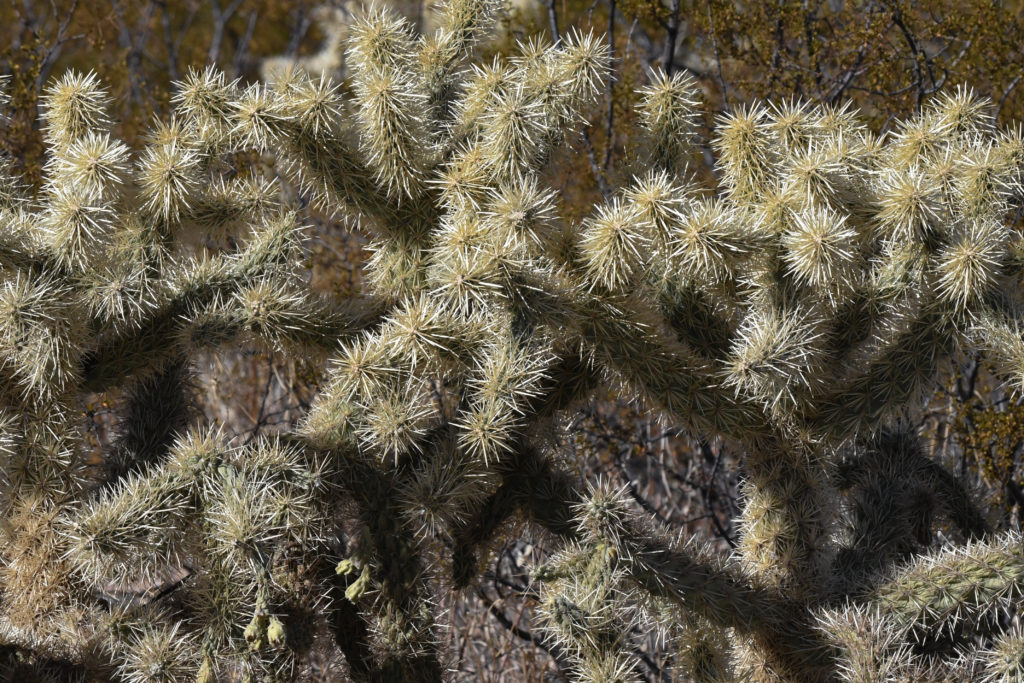
Teddybear Cholla
Barrel

Aptly named for their short round shape, the Barrel cactus may live for 130 years and grow 6-11 feet in height. This cactus has ridges on all sides that are covered with large and small spines, both sizes serving a different purpose in helping the plant thrive in extreme conditions. A fun fact about this cactus is that it often leans toward the southwest, in case you need a navigational aid.
There are actually 3 different species of Barrel cactuses in the Sonoran Desert. They most often grow along rocky slopes, canyon walls and desert washes. The young ones tend to be pinkish-purple in color but grow to be golden and green. The flowers of these easy to identify cactus are a variety of colors and grow on top of the plant from April through June. The inner pulp is sometimes used to make candy which you may find in local shops.
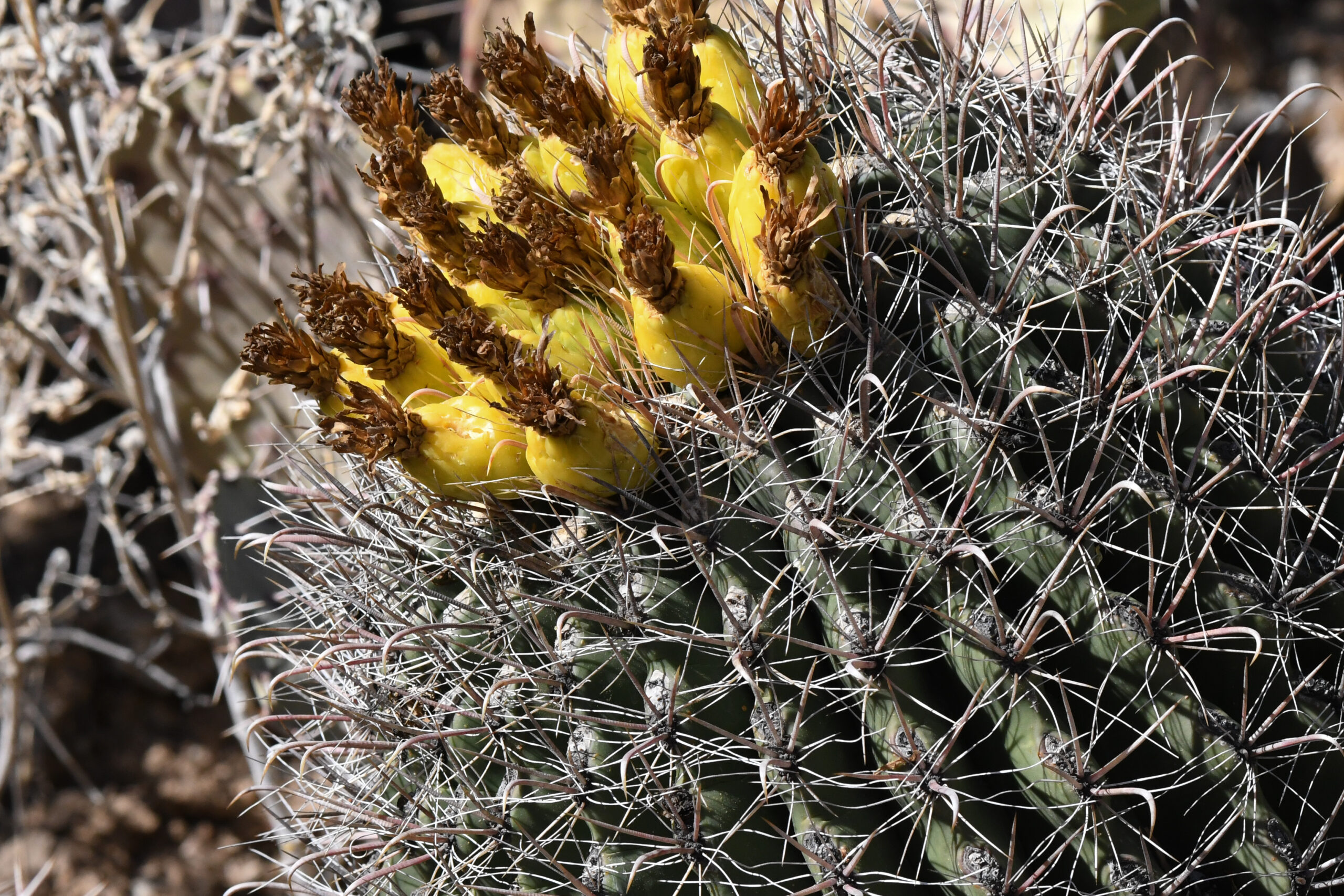
Barrel Cactus
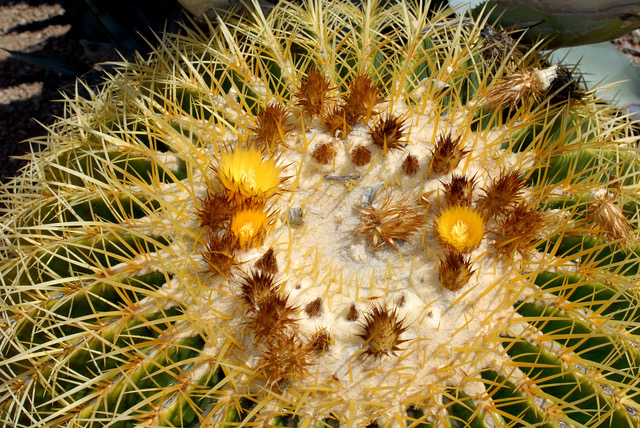
Golden Barrel Cactus
Prickly Pear

Engelmann’s Prickly Pear
Commonly seen across the southwest, midwest and east, this cactus sports broad flat lobes that grow white spines up to 3 inches long. Prickly Pears grow to be 10 feet tall and 15 feet wide and live more than 20 years. The yellow flowers bloom in May and June; the red-purple fruit is evident in July. This is another favorite with pack rats – look closely and you may discover one nesting at the base of a Prickly Pear. The lobes can be eaten raw once the spines are removed, or made into candy and wine. Local restaurants may include these on their menus.
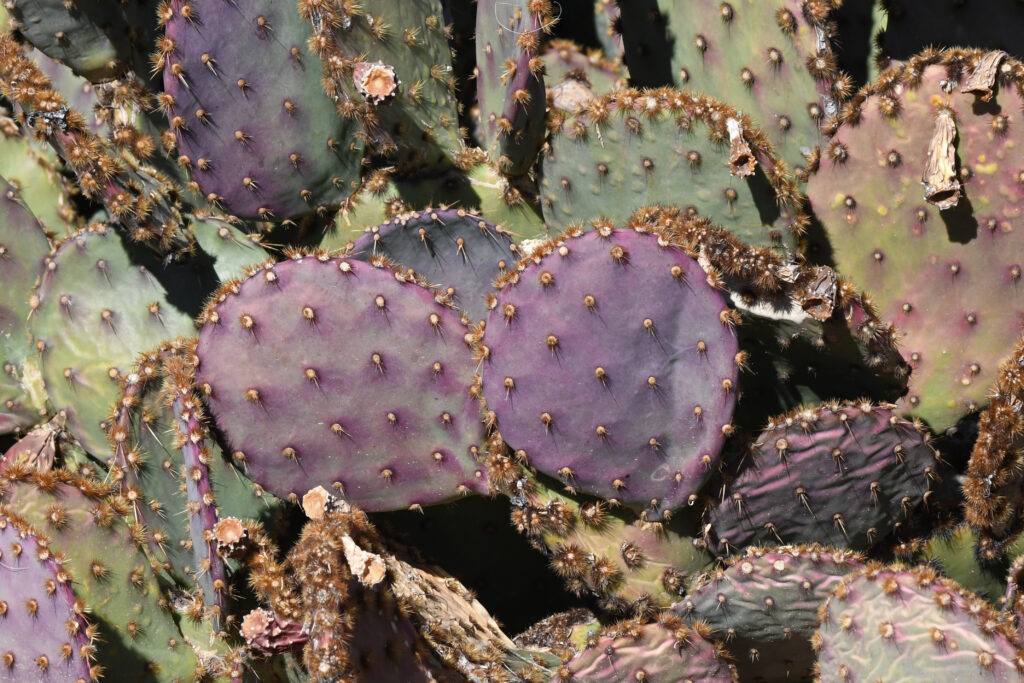
Prickly Pear Cactus
Hedgehog
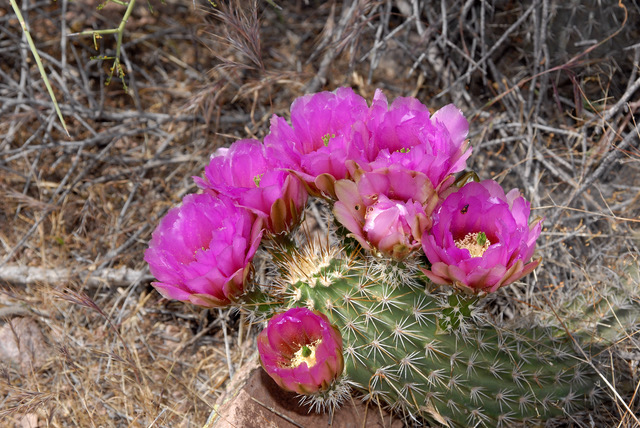 This cactus, named for its hedgehog shape, bears arms (stems) that grow in clumps and are 12 inches tall with spikes that can be 3 inches in length. The plant grows low to the ground and can be found almost anywhere in the Sonoran Desert and beyond. The flowers, a vibrant purple or pink, close each night and reopen in the morning. Edible fruit develops once flowering is complete. As the fruit matures the spines fall off making it a favorite treat for rodents and birds.
This cactus, named for its hedgehog shape, bears arms (stems) that grow in clumps and are 12 inches tall with spikes that can be 3 inches in length. The plant grows low to the ground and can be found almost anywhere in the Sonoran Desert and beyond. The flowers, a vibrant purple or pink, close each night and reopen in the morning. Edible fruit develops once flowering is complete. As the fruit matures the spines fall off making it a favorite treat for rodents and birds.
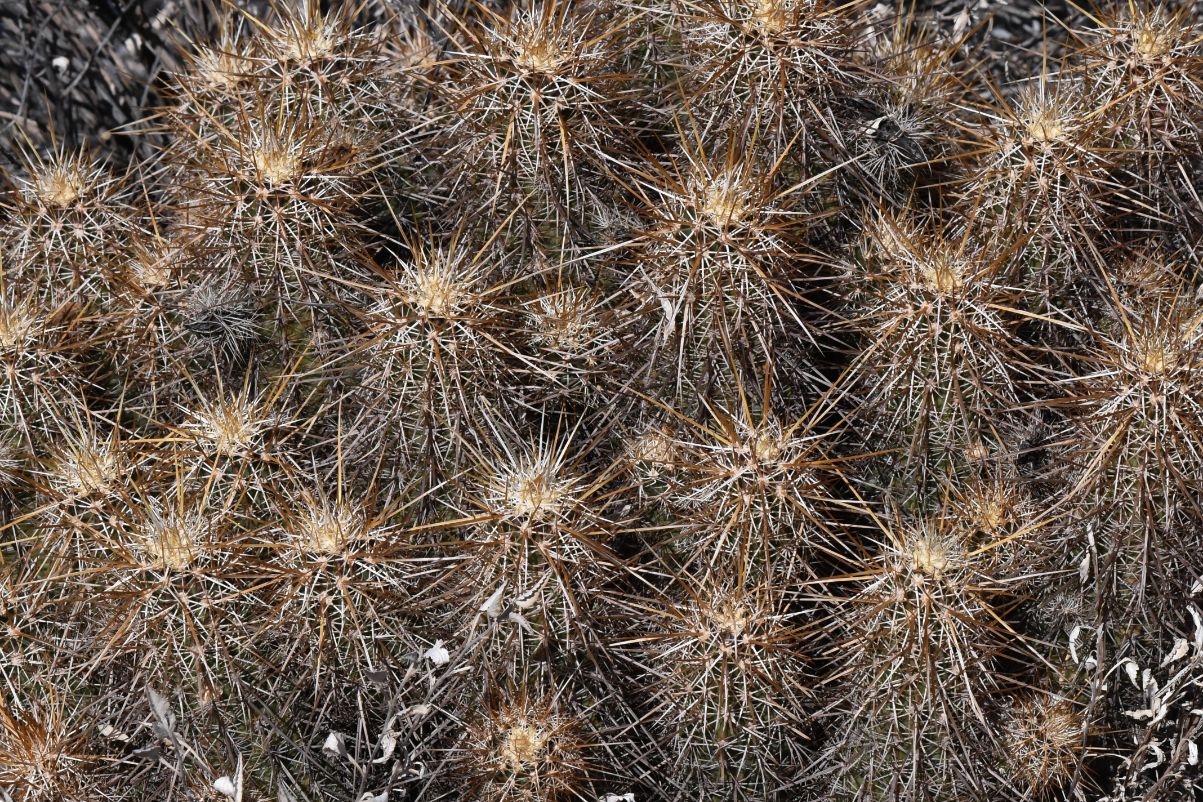
Favorite Places to See a Variety of Cacti
- Boyce Thompson Arboretum in Superior (45 minutes from Mesa)
- Desert Botanical Gardens in Phoenix
- Lost Dutchman in Apache Junction
- McDowell Sonoran Preserve in Scottsdale
- Saguaro National Park in Tucson (worth the drive!)
- South Mountain Park and Preserve in Phoenix
- Superstition Mountains surrounding Phoenix
Note: A personal favorite is Organ Pipe Cactus National Monument which is close to the Mexican border. Well worth the drive, you will see lots of beautiful Organ Pipe and large Saguaro scattered throughout.

Save money and support local business by booking directly through
Arizona Vacation Home Rentals
Phone/Text: 480.626.4072
Photo credits: © Gilbert S Grant
*By providing links to other sites, AVHR does not guarantee, approve, or endorse information or products available on these sites.
The greater Phoenix area which includes the East Valley is the shangri la for golfers with public and private courses at every turn. We’re also a paradise for the avid or casual hiker, biker* and horseback rider with miles and miles of trails extending in every direction.
The Biodiversity of the Desert
You might envision only flat terrain because our home is a desert. The Sonoran Desert, however, is strikingly diverse in geological structures: we have mountains that will take your breath away both in challenging climbs and magnificent vistas! Our myriad of trails accommodate and challenge all skill levels and include exciting topography and ascending elevations.
I’ve hiked some of the trails included in this blog. The scenery, vegetation and wildlife are especially rewarding, no matter the altitude or time of year. Most days you need a hat, sunscreen, sunglasses and sturdy shoes. Winter months may dictate a sweatshirt or warm jacket and hat. For all seasons, a camera, binoculars and field guides are essential items in my day pack.
Be Safe and Comfortable
Subtropical deserts such as the Sonoran Desert are ecosystems characterized by high temperatures and very low annual precipitation. Checking the weather in advance of your leg work is much advised since our typically warm temperatures can be extreme and should not be underestimated. Keep in mind that trail difficulty levels are raised one level when temps are greater than 100℉. Dogs are not permitted on the City of Phoenix hiking trails when the temperature reaches 100 degrees or higher.
Subscribe to safety and take our heat seriously! Unless you’re a roadrunner, it’s critical to hydrate before you go, carry enough water to stay hydrated and hydrate upon your return. Always carry more water than you expect to need. Snacks are important, too.
The Sonoran Desert receives 3-15 inches of rain annually. This most often occurs in our monsoon season, July through September. During those times a lightweight rain jacket may be prudent. Our monsoon season is also the time to be alert for flash floods and mudslides caused by torrential rain on land that is impermeable to water. Be aware of your surroundings and particularly of dry washes which can fill with fast moving water in a matter of minutes.
Other safety tips include formulating a plan, informing someone of your plan before you go, traveling with others and remaining alert to wildlife. Taking a first aid kit and a fully charged cell phone are also wise choices.
Please and Thank You
More than 100 reptiles, 2000 native plants, 60 mammals and 350 birds call our desert home, thriving only if the habitat is maintained. Please minimize your footprint and leave no trace by:
- Staying on trails
- Respecting wildlife
- Not altering the landscape
- Taking all trash with you

You’re Off to Great Places
I’ve organized this list of parks and preserves under the nearest city. If you consider yourself to be more of a “walker” instead of a hiker you will also find information on stellar walks where you can view native plants, wildlife and captivating scenery. Links are included to provide the trail details you need: level of difficulty, unique characteristics of trails and crucial maps. Some of the links offer information about all of the trails, parks and preserves included in this blog. The variety in links is not to confuse you but to help you find what you need in a preferred format. At the end are several of Arizona Vacation Home Rentals’ properties that are either adjacent to or a short commute to trails.
Mesa
The Hawes Trail System in NE Mesa consists of well marked, single lane biking and moderate hiking trails that intersect and form loops. There is a map at the trailhead on N Power Road/N Bush Highway in Las Sendas which you can use to design your own course for the desired distance. Views of Usery Mountain, Red Mountain, the Salt River and Granite Reef Dam are all possibilities.
Usery Mountain Regional Park has 29 miles of multi-use trails for hikers, bikers and horseback riders with a staging area for horses. Trails range in difficulty and distance and provide spectacular views of the surrounding plains. The popular Wind Cave Trail allows hikers to climb up into the mountain and connect to trails in the Tonto National Forest.
The Lower Salt River Nature Trail offers a leisurely 2.5 mile loop along the appealing Salt River. Access and parking is on Phon D Sutton Road off of the N Bush Highway. This nature walk promises wildlife sightings of horses, wading birds, deer and more.
Boulder Canyon Trail is northwest of Mesa near Tortilla Flat and offers an 8.7 mile out and back jaunt for the more experienced hiker. The trail starts at and returns to Sagaro Lake and provides worthwhile views of Battleship Mountain and other splendid Superstition Mountain scenery.
Rio Salado Pathway, also known as Tempe Town Lake Trail, is comprised of two distinct trails on either side of the Salt River. Trail riders may choose to continue on the trail north of the river all the way to downtown Scottsdale. Access to the Rio Salado Paths are at Riverview Park in Mesa and Tempe Beach Park in Tempe.
Dreamland Villa Desert Nature Walk is a one mile strip that by design features native vegetation for the purpose of attracting wildlife. This walk is intended for hikers; bikes are not permitted on all sections. Longer hikes are possible by using available maps and directions.

Hawes Loop Trail System
Scottsdale
McDowell Sonoran Preserve features three trails that were created to be accessible to individuals of all ages, including those who use wheelchairs for mobility and are hearing and/or visually impaired. Along the way are interactive displays with a universal design to educate people with a wide range of abilities about the surrounding ecosystem.The McDowell Sonoran Preserve Trailheads are organized by north and south regions. The amenities and skill levels are different for each one. Several trailheads provide places for loading and unloading horses.
McDowell Mountain Regional Park is northeast of Scottsdale and has more than 40 miles of hiking, biking and riding trails. Trails range from easy to difficult and .5 to 15+ miles in distance. Trails are multi-use unless designated otherwise. There are staging areas for horses.
Pinnacle Peak Park has a moderate out and back 3.5 mile trail with the highest point on the peak at 2,889 feet. There are also rock climbing routes and interpretive displays along the way. Bikes and dogs are not permitted on the trail.
Black Canyon Trail is 75+ miles of challenging off road trail connecting north Phoenix to the Prescott National Forest. This challenging trail is mostly used by mountain bike riders and runners. The trail winds through the Sonoran Desert and includes both saguaro forests and rocky canyons. Be alert to flash flood warnings as canyon washes in lower elevations may become dangerous in a few short minutes.
Gilbert
Riparian Preserve at Water Ranch is 110 acres of ponds and vegetative zones with 4.5 miles of easy walking, biking and horseback riding trails. Opportunities to view wildlife are promising with more than 295 bird species visiting throughout the year and fish, reptiles and amphibians making the preserve their home. Binoculars, cameras and field guides are highly recommended.
San Tan Mountain Regional Park is southeast of Gilbert and Chandler in Queen Creek. The more than 10,000 acre park includes trails that are well known for their diversity in wildflowers and native wildlife relative to the elevation. Goldmine Mountain stands high in the northern region of the park. Elevations range from 1,400 to almost 2,600 feet.
Phoenix
Phoenix Sonoran Preserve is north of the city and features 3 trailheads and over 36 miles of trails in mostly undeveloped desert. This preserve is a newer city venture to connect hikers and riders to the beautiful landscapes within the Valley.
Phoenix Mountains Preserve is just 20 minutes from downtown Phoenix and offers parks and peaks with miles and miles of trails for riders and hikers. The numerous trails range in difficulty and distance. This Phoenix City map provides a detailed overview of the parks and trails that are part of the preserve. Camelback Mountain is one of the most popular hikes in the Phoenix Mountains Preserve and features two challenging trails with steady climbs: Echo Canyon Trail and Cholla Trail. Plant and animal species are prolific on both climbs. Expect spectacular 360° city and desert views from the top of the summit which resembles a camel’s hump.
South Mountain Park and Preserve is a large municipal park with more than 58 miles of hiking, biking and horseback riding trails for all skill levels. There are several places to access the park, depending on the trails(s) you are interested in exploring. Anticipate spectacular mountain views when you reach the mountain tops. Looking for an escape from motor vehicle traffic? Check out Silent Sunday in which the park’s main road is closed to motor vehicle traffic but open to non-motorized activities such as walking, cycling, jogging and hiking.
Papago Park offers miles of trails that are easy for walking or biking with little climb in elevation. The park is split by the Galvin Parkway into east and west sections. There are appealing trails in both sections with impressive views of Phoenix and Tempe from some unique vistas. Nearby attractions include the Phoenix Zoo, Desert Botanical Garden, Arizona Heritage Center and the Papago Golf Club.
Lost Dutchman State Park is 40 miles east of Phoenix and contains trails suitable for beginners to more advanced hikers. The trails wind through the Superstition Mountains making appropriate footwear, suitable gear and adequate hydration critical.
Payson (90 minutes north of the East Valley)
The Mogollon Rim near Payson offers amazing views as you hike through lush deciduous and pine forests and along lakes, springs, rivers and waterfalls. Trails range in levels and distance; rim views encompass hundreds of miles. Expect cool to cold temperatures and prepare accordingly. Waterproof footwear and gear is highly recommended.
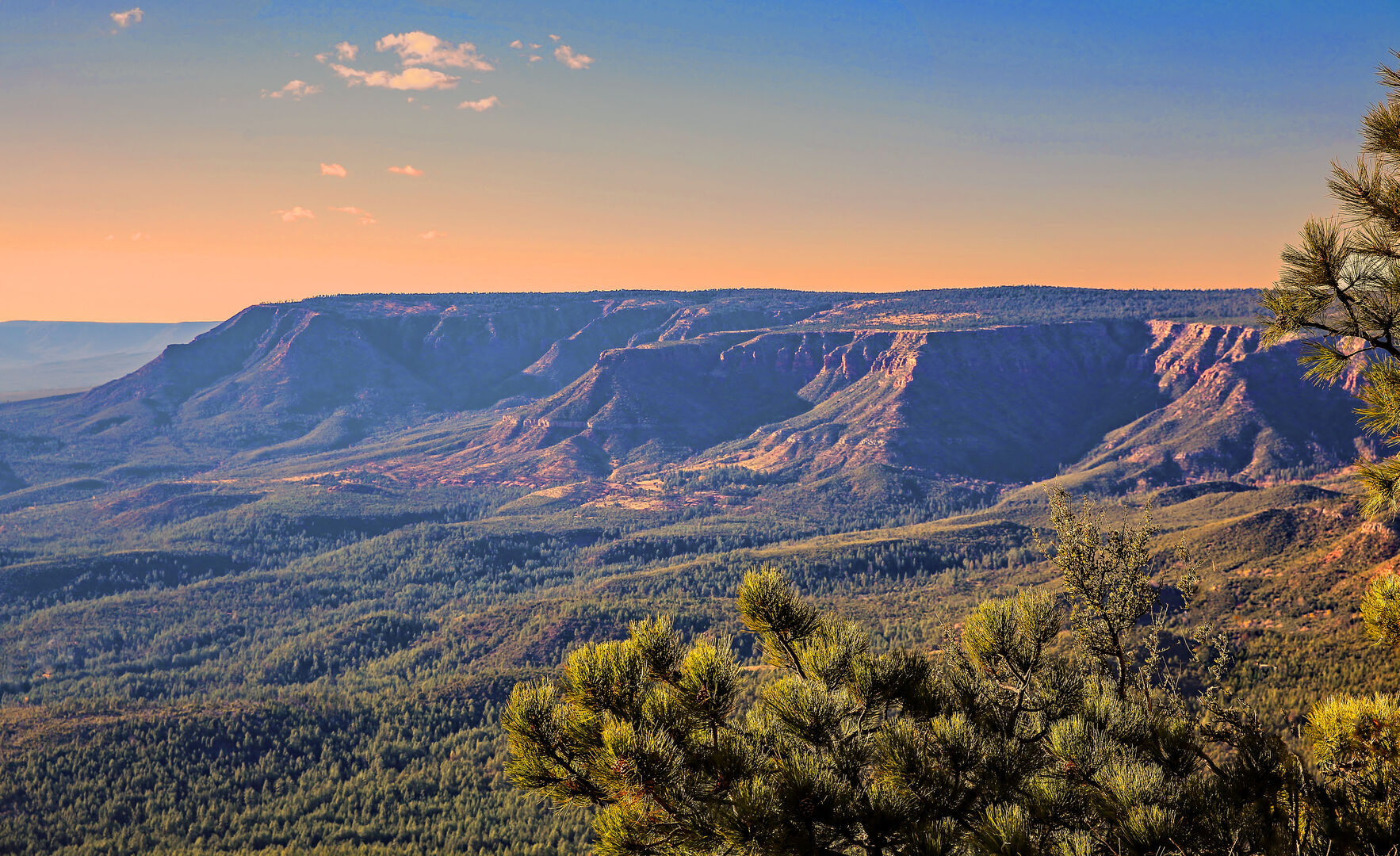
Mogollon Rim
Arizona Vacation Home Rentals has several homes with trails adjacent to the property or community:
- Diamond Spirit Ranch in Payson connects to Tonto National Forest trails.
- Gold Canyon Retreat in Mesa has Superstition Mountain trails behind the home.
- Gold Canyon Trails in Mesa has a path that leads to the Hieroglyphic Trail in the Superstition Mountains.
- The Castle Resort in Mesa has hiking and biking trails that border Usery Mountain Regional Park in front of the home.
- Valley Vista in the San Tan Mountains is a short drive to San Tan Mountain Regional Park in Queen Creek.
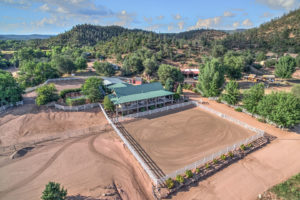
Diamond Spirit Ranch
Save money and support local business by booking directly through
Arizona Vacation Home Rentals
Phone/Text: 480.626.4072
*This article is intended to serve the interests of non-motorized bikers only. Guests will need to read trail and park details to locate ones that permit motorized bikes.
By providing links to other sites, AVHR does not guarantee, approve, or endorse information or products available on these sites.


